


















GUYANA is still struggling with a shortage of labour to meet growing demand and as a result, the government will be making a last effort to comb across the country with the hope of finding as many Guyanese as possible to fill the void.

This is according to President, Dr Irfaan Ali, who during a press conference on Friday in Region Six responded to questions about complaints from the private sector in that region about the shortage of the much-needed labour to match the rate of the construction boom being fuelled by the massive infrastructural development.
The Head of State explained that the issue is not confined to Region Six alone, as it is an issue facing all regions due to the ongoing countrywide development.
“Our country is going through a very important phase and this phase requires more from each of us. Labour shortage is a major, major issue that is going to face us. All private entities in the region
are complaining about [the] shortage of labour. It’s a national complaint,” the President noted.
“In the housing sector and the building sector alone, in this region, we will need maybe another close to 600 skilled, semiskilled or unskilled workers, just to deliver the houses that we plan on
doing this year. Then, you multiply that across the country in every single region, you understand the net national effect.”
Since last November, President Ali had noted that the labour shortage had been slowing down work in the construction sector by as much as 30 per cent. Over the past
two years, the country has been undergoing major infrastructural development to match both a massive need for housing, as well as to make up for the country’s infrastructural deficit.
The construction of houses, as well as roads, bridges and other infrastructure, has been mov-

ing at an expeditious pace. With a small population of just 750,000 people, the country is faced with an inevitable challenge of finding the necessary supply of labour and skillsets required for the pace.
Though the government has not ruled out the option of importing labour from other countries, every effort is being made to ensure that as much of the labour as possible comes from Guyana.
The government has constantly lobbied to persons during community outreaches to capitalise on the low-hanging fruit. However, the shortage continues.
“What we’re doing now is making our final effort combing across the country to see all those who are available and ready to work. We are mobilising. We are also talking to some of the persons that talked to us,” the President noted on Friday.
The call for Guyanese to fill the void has not only been limited to those at home, and, the President noted, it is being seen that Guyanese from the diaspora have started responding to the call.
“We are seeing a lot of re-migration from Suriname. A lot of skilled persons coming back from there, from Barbados, and from the Caribbean, especially. And you are seeing more of these persons appearing now which tells you that something is going on and they are responding to the opportunities back home here,” the President said.

Also speaking about the issue during a telephone interview with the Sunday Chronicle, Minister of Labour, Joseph Hamilton noted that his ministry is also doing its part to try to get Guyanese into filling the openings.
Through the Board of Industrial Training (BIT), and Central Recruitment and Manpower Agency (CRMA), the ministry has continued to inform the public of the opportunities available in the construction sector.
WITH development in almost every area of agriculture, Region Six (East Berbice- Corentyne) is playing a major role in Guyana’s overall contribution to the ‘25 by 25’ initiative.
Speaking at a press conference in that region on Friday, President Dr Irfaan
Ali noted that the government continues to open up tens of thousands of acres of new land there to expand the production
“Region Six is a major player in the ‘25 by 2025’ initiative in every area ; in livestock, in aquaculture, in grains, the cash crop, in processing We’re building a facility now for processing and
packaging in Black Bush ; we ’ re seeing expansion of farming and farming opportunities, so it’s enormous,”
the President explained
The economy of Region Six is powered primarily by farming, especially rice farming and cash-crop farming The region has also contributed tremendously to the rapid increase of Guyana’s shrimp production, with the expansion of 1,833 acres of ponds there
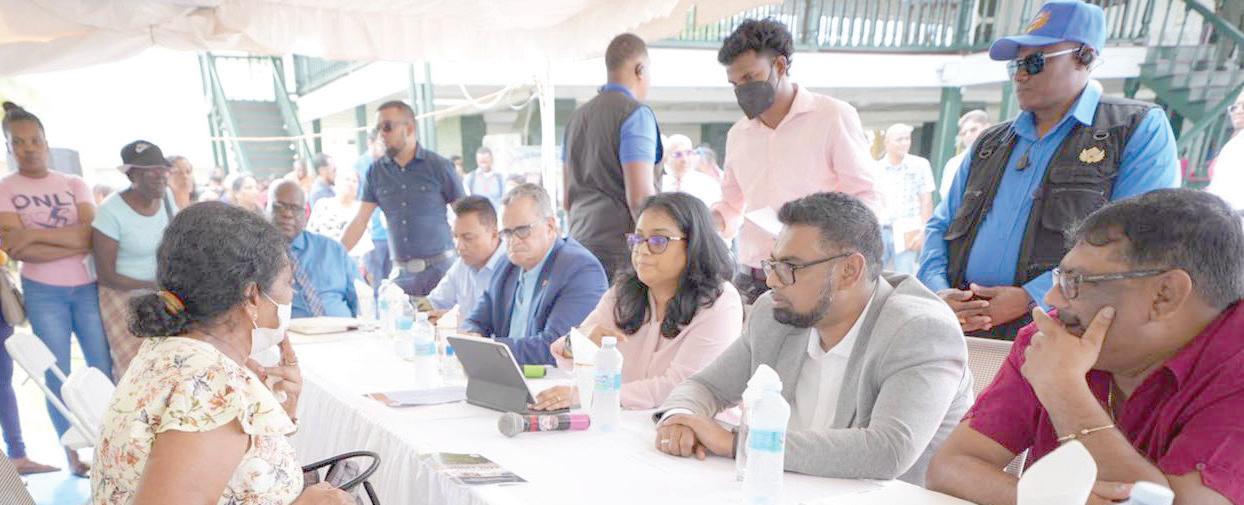
“ Tens of thousands of new lands ; we ’ re opening up new lands for production in the region In the Canje Creek , in Baracara , we ’ re spending tens of millions of dollars in empoldering ; in bringing new land into production More farmers
are being deployed into the lands,” the President boasted
The ‘25 by 25’ initiative is a pledge by the Heads of Government of the Caribbean Community (CARICOM) to reduce the region’s food import bill by at least 25 per cent by 2025
Research has shown that the region imports, from out of the region, approximately 80 per cent of the food that it consumes, which amounts to approximately US$4 billion
Though for years there has been calls for greater domestic food production to address the massive food import bill, the proposal found reinvigorated energy among the region ’ s governments last year as it faced some of the worst sides of the food
insecurity that the world experienced due to the war between Ukraine and Russia.
The war had further exacerbated food security concerns during the COVID-19 pandemic Guyana is seen as one of the leading countries in the region with the ability to increase production in the region and fill some of the gaps
In Guyana, the government has been committing much resources , including lands and funding, towards this initiative
“ What we are doing in agriculture is trying to create a lot of opportunities for young people , using technology, innovation, research and development ; more of an entrepreneurial approach
to the expansion of food production and agriculture in the region,” the President noted.
He explained that the expansion in the agriculture sector is being built to match the growth taking place all across Guyana, in all of the other sectors, and fuelled by the massive gains Guyana is seeing from its oil-and-gas sector

While Guyana is earning significant income from its oil resources, the government has maintained that agriculture must continue to hold its own To ensure that this status quo is maintained, the agriculture ministry is implementing a series of initiatives in the various agriculture pillars to provide the necessary resources to drive the sector forward
The money from that
sector is being used to fund Guyana’s diversification in other sectors.

“New hospitals coming on stream; more doctors… We’re expanding training programmes for nurses. We’re deploying more resources to training specialist doctors that will be deployed regionally; so the investment is wide; it’s covering different sectors. I will say agriculture is a main part, however,” the President contended.
In the 2023 budget, over $79 million has been directly given to Region Six for agriculture initiatives, including the rehabilitation of bridges and revetments at Rotterdam , Nos . 62/63 and 53/54 façade, Razack Dam and Moleson Creek, and the purchase of tractor.
USED to treat a range of cancers and chronic diseases, stem cell and immunotherapy services were on Saturday introduced for the first time in Guyana by Woodlands Hospital in collaboration with Fidelity Healthcare Ltd, a registered medical company in Trinidad and Tobago.

Immunotherapy is a type of cancer treatment that uses certain parts of a person’s immune system to fight against cancer. This can be done in two different ways: either by stimulating one’s immune system to work harder or smarter to attack cancer cells; or, by giving your immune system components, such as man-made immune system proteins to do the same.
In sharing his personal experience of using this treatment at the launch, Dr. Pramod Tembe, of Woodlands Hospital, revealed that at the age of 16, he began suffering from an autoimmune disease that partially handicapped him. He would experience severe back pains and his spine became stiff. He related that he would take painkillers but in 2019, he met a doctor and friend in Trinidad and Tobago who proposed stem cell therapy to him.

Given that he had little to lose, even though he was quite skeptical, Dr. Tembe said he went ahead with it. He explained that stem cells were taken from his bone marrow and injected into his spine and today, after going through
the process, he is standing, literally.
Dr. Tembe said that the immune system has a tremendous capacity to kill bacteria and viruses.
“With immunotherapy, we are going to teach our immune system to fight against this kind of cell. Not only that, we are going to create artificial immune cells in the lab and introduce it to the body to kill the cancer cells,” Dr. Tembe explained.
Further, he stated that the vaccine, when entering the body, is going to find the cancer cells and not only is it going to kill them, but because the T cells have memory cells, if the cancer were to come back, it would kill it right away.
The hospital will be offering two types of treatment – Cancer Immunotherapy and Stem Cell Therapy.
“At Woodlands Ltd., we are initially offering autologous dendritic cell
therapy-based immunotherapy which is approved for use in several countries across the globe given its demonstrated effectiveness in increasing survival rates of patients with cancer,” the hospital stated.
Additionally, the US FDA has approved the treatment for prostate cancer, and Indian FDA (Central Drugs Standard Control Organisation) for malignant solid tumors such as prostate, ovarian, colorectal, and lung cancer.
The second type of treatment that will be available in Guyana for the first time is stem cell therapy, also known as regenerative medicine. This type of treatment promotes the repair response of diseased, dysfunctional, or injured tissue using stem cells or their derivatives.
“Through our collaboration with Fidelity Healthcare Ltd we will work to harness the therapeutic benefit of autolo-
gous bone marrow derived stem cells and Mesenchymal stem cells for the treatment of chronic diseases like diabetes, autoimmune diseases, muscular dystrophy, orthopedic disorders, stroke, amyotrophic Lateral sclerosis, pulmonary fibrosis, COPD, and spinal cord injury, among others,” the hospital noted.
Meanwhile, President, Dr. Irfaan Ali, speaking at the launch, said that he is of the strong view that with the resources Guyana has in the health sector, the combined ability of medical talent can match any across the world.

He noted that if medical science is dead, then healthcare and technology would be dead.
President Ali continued: “That is why we now must move to this new level which I intend to elaborate on in the coming days to the establishment of a national medical scientific council.”
Additionally, Minis -

ter of Health, Dr. Frank Anthony, said that stem cells have a beneficial role to play which can be seen from over the past years where stem cells have been used to correct damages to various organs in the body.
“What we are also witnessing is that there is a shift in how we do and how we practice medicine. It is no longer medicine where one size fits all,” he said.
The Health Minister noted that Guyana is now moving to precision medicine where the healthcare providers will now understand more about a person and their genomics, and then based on their genomics, manufacture medicines that are specific to that person, and to be able to fix
whatever ills that person may have.
“That is where medicine is going and the area of stem cell. While a lot of research is being done, we’ll see a lot more happening in this area,” he said.
Minister Anthony added: “We, as a government, recognise that this is going to be a potential area for growth and we want to be one of the places in the Caribbean… in Latin America where we can be pioneering this this type of technology.”
According to Dr Anthony, the Human Organ and Tissue Transplant Act 2022 caters to regenerative medicine which include stem cells, and Guyana is hoping to develop in this field.
(Reuters) - Newly elected Brazilian President Luiz Inacio Lula da Silva is considering an income tax exemption for workers who earn two times
the minimum wage, or just over 2,600 reais ($504.64) a month from 1,903 currently, two sources with knowledge of the negotiations said on Sat-

partially fulfill one of Lula’s campaign promises – to raise the exemption even further to cover workers earning the equivalent of 5,000 reais, a move that would increase the disposable income of those who earn less in the country, said the sources anonymously.

urday.


The idea, still under review, is to at least
The information on the measure was first reported by newspapers Folha de S. Paulo and

O Estado de S. Paulo. While it could reduce income inequality, a broader exemption would reduce tax revenue at a time when the economic team seeks to reduce the strong primary deficit expected for 2023 and signal fiscal discipline.
As Reuters reported on Friday, the government is also considering raising the minimum wage to 1,320 reais
from May. That means that the exemption, if decided, would apply to workers earning up to 2,640 reais monthly. Workers who currently earn up to 1,903.98 a month do not pay income tax, a figure that has not been updated since 2015, implying, in practice, an increase in the tax burden on Brazilians with lower wages.
PRESIDENT, Dr Mohamed
Irfaan Ali has recently concluded a two-day outreach programme in Region Six and from all indications it was a highly productive engagement with residents of what is known as the ‘Ancient County.’
It was a case of taking government to the people, something which has now become the hallmark of the PPP/C administration. This is yet another manifestation of grounding with the masses in keeping with the peopleoriented approach of development embraced by the PPP/C administration.
People are not only the beneficiaries of development but the reason for all development and whenever there are obstacles in the way of such
development, they have to be removed with dispatch.
It is exactly this thinking that is at the root of the several interventions made by President Ali and his team of officials to the several regions of Guyana. In the case of Region Six, the team was able to resolve hundreds of issues and engage over 2,000 persons during the two-day visit.
Over 16 ministries and agencies were represented at the engagements which saw, in several instances, on-thespot solutions to a number of festering issues.
But for many, it was not only an opportunity to engage the President in dealing with issues of concern, but also the joy of meeting and interfacing with the President at a personal level. Hundreds, if not
thousands of individuals who had the opportunity of meeting with the President left fulfilled and were touched by his simplicity and down-to-earth manner in which he related to them and their issues.
Delivering services to the people, it must be said, is not doing them a favour. It is an entitlement and it simply cannot be business as usual when unnecessary bottlenecks are placed in the way of service delivery, especially by bureaucrats who are paid to ensure the delivery of such services.
It is a fact that many issues could have been resolved at the agency level but because of undue bureaucracy, such problems remain unresolved for an inordinate length of time, resulting in
much frustration, inconvenience and, in some cases, distress by those affected.
The joy in the faces of those whose problems were resolved by the on-the-spot interventions of the President are all too familiar and the President must be commended for the proactive measures he is taking in addressing the concerns of the Guyanese people.
As pointed out by President Ali, governance is serious business. “We believe strongly in serving the people. We are not a government that is distant from the people or a government that operates in a vacuum or in a locked compartment. That is not how we operate. We operate with you, taking your concerns and
realities into consideration,” the President emphasised.
This is not just talk. Indeed, since assuming office President Ali and his team of government officials have been working in every community. This initiative, according to the President, will be replicated in all the regions of Guyana.
The visit to Region Six comes on the heels of the passage in the National Assembly of one of the biggest budgets in the country’s history. But, as pointed out by Senior Minister in the Office of the President with responsibility for Finance, Dr Ashni Singh, preparation and passage of the budget is one thing, but implementation of the budget is what really matters. As such, there can
be no room for complacency or inertia.
President Ali has been leading by example in this regard and it is imperative that all those who are in positions of responsibility rise to the challenges of national development. This requires a high level of commitment and discipline which the President has been demonstrating throughout his interactions with the Guyanese people.
This was summed up quite well by one resident when he said, “I feel happy to know we have a President not on promise; he is on time and he speaks his words and it come to pass. I believe that’s what the people need, a man with a vision. One who speaks words and it come to pass.”
Dear Editor, OUR citizens’ patience has been stretched and tested in anticipation of the Guyana Elections Commission (GECOM) hosting of the outstanding LGEs. One should not expect that such tolerance will be indeterminately elastic. By now it is recognised that the delaying strategies of opposition forces will not stop, and every excuse will lead to another frustrating suppression.

The PPP/C government has since provided critical resources to complement each year of hopeful promise, and GECOM is now expected to deliver and remove the stymieing of benefits to our citizens. The government’s recent 2023 budget, generously recommends financial allocations of G$5.2 billion for the use of GECOM. Notably, these provisions come into play following significant allocations since 2021 when G$1.8 billion was pro-
vided, followed by a revised G$2.9 billion in 2022.
Understandably, the March 2020 debacle concerning the abusive attempt to steal power by opposition forces at the General and Regional Elections, informed necessary adjustments to the abused controls. But have not been to the extent that the necessary remedial position cannot be put in place to deliver the LGEs promised in 2021, 2022, and now 2023.
The LGEs was last held in 2018, highlighting the way overdue timeline on the legal schedule. While these elections cannot supersede priority over any General and Regional elections call, the overwhelming, flimsy excuses from the opposition lack the potency of any significant reasons for further delays. Of note, GECOM has followed the legal framework for preparation of the list of voters, and we must have the elections now.
The Chairperson Justice Claudette Singh must assert herself and not allow any commissioner to frustrate the work of the commission. It is indeed heartening to read and hear that the commission adopted the report from the Chief Elections Officer (CEO) confirming changes to some constituency boundaries.
There is now a more representative position in many Local Authority Areas which takes into consideration population shifts influenced by the PPP/C’s massive housing drive, and corrects previous deliberate gerrymandering designed at providing the opposition specific advantages. Consequently, the commission through its secretariat would be in an enabled position to prepare an updated register of voters in the respective Local Authority Areas.
The ongoing continuous registration process comes

after a previously announced and again delayed LGEs date set for March this year. The process, however, will allow GECOM to have all the relevant information that would be up to date to a determined cut-off point. It follows that with a short period of Claims and Objections, preparation of the register of voters will be completed. Once achieved, the CEO is required to present the updated voters list to the commission for ratification, enabling the chairperson of the commission to write the Minister of Local Government expressing GECOM’s readiness for the holding of the LGEs.
Further, it is applaudable that over the past months, GECOM utilized provided taxpayers’ resources, to train identified persons who are expected to work at the LGEs. The utilised expenditures cannot be allowed to be defused uselessly, at the expense of necessitating
a full set of training. In this respect, there are national expectations that the CEO will now move swiftly to prepare his work plan in preparation for the holding of LGEs at the earliest date.
Editor, there is no doubt that the upcoming local government elections will serve as a reminder of the PPP/C government’s commitment to good governance and transparency across every community, and will provide much-needed renewal to the local government system. With the massive allocation for the holding of LGEs, GECOM must uphold its mandate and hold the elections to strengthen local democracy.
The present process of continuous registration seems to be going smoothly. Both the category ‘A’ and the category ‘B’ citizens are making full use of the opportunity to get registered. The government recognises and delivered on its commitments,
and the budget will certainly help to establish a realistic platform to guarantee a better life for our people.
It cannot be denied that the PPP/C government has moved with expedient speed in advancing its committed development agenda while synchronizing the benefits for citizens across a “one Guyana Platform.”
There is also genuine awareness that the opposition cabal will stop at nothing to derail this upward trajectory. Consequently, GECOM must not find itself influenced by the naysayers trying desperately to make our people collateral damage. The commission, led by Retired Justice, Madam Claudette Singh MUST ensure delivery of the organization’s mandate, freely and fairly.
This column calls on GECOM to move the process forward now!
Sincerely,
Neil KumarDear Editor, HERE are some critical questions that come to mind for which the transparency advocate ought to provide answers to the Guyanese public:

1) It appears that she is suing Exxon and the GoG on behalf of the Guyanese people’s interest by way of protecting the environment. What is she suing Exxon for exactly?
2) Is it a declaration? If so, what are those declarations?
3) Is it for monetary compensation on behalf of the Guyanese people? If so, how much?
4) And if she wins this case, what will she do with the money she is suing for, if that is the case?
5) Will the money be deposited into a special fund?
6) Will it be transferred to the Consolidated Fund?
7) Will it be used in community development projects?

Notwithstanding the foregoing, for arguments sake let’s examine the merits and demerits of the attorney’s reasoning for the lawsuit against ExxonMobil–that is, fossil
fuel is dangerous to the environment and that the risks it poses to mankind are deadly.
There is no doubt that fossil fuels are not climate friendly, and that the world needs to transition to cleaner sources of energy.
It is within this framework that the development and exploitation of the resource need to be done in a sustainable manner and in a way that minimizes the environmental risks. These are also the new guiding principles upon which the global industry operates.
In spite of this, the international attorney and transparency advocate opted to pursue an extreme position in addressing these issues with the oil companies in two ways: (By exaggerating the risks of the operations without credible scientific evidence and driving an extremist campaign for the oil companies to cease oil production in Guyana (only).
In order to rationalise this view, a reasonable question to ask is what would happen to the world and to the life of people if all of the oil companies were to cease oil
production forthwith? To lend context to this notion, let’s examine an overview of the global energy-transition agenda and its potential impact on the future of the global oiland-gas industry.
The global transportation sector will be one of the main drivers of demand for crude over the next 30–50 years, and at least 40 per cent of the worlds energy needs will need to be supplied by oil and gas by 2050. Hereunder stated are some interesting facts:
GLOBAL STOCK OF COMMERCIAL AIRCRAFT
• The global commercial aircraft fleet stood at 29,000 in 2020
• Estimated to grow by four per cent annually to reach 39,000 by 2028
• Annual production is 1,000
• It takes five-six years on average to build an aircraft, in some cases, 10 years
• To replace all the aircraft in the world it will take 29,000/1000 = 29 years to build and replace, plus 10 years to develop electric planes total number of years to replace all the aircraft glob-
ally to electricity will be approximately 39 years
GLOBAL STOCK OF CARS
• As of 2020, this figure is some 1.2 billion cars globally, of which 7.2 million are electric cars (six per cent of global cars are electric)
• Global average rate of production for electric cars is 2.1 million, which means it will take 571 years to replace all the cars in the world to electric cars
GLOBAL STOCK OF TRUCKS/COMMERCIAL VEHICLES
• As of 2020, an estimated 425 million of which 27.2 million or 6.4 per cent are electric commercial vehicles
• The annual average production rate of electric commercial vehicles is 6,000, at which rate it will take 70,833 years to replace all the commercial vehicles in the world to electricity at the current rate of production.
GLOBAL
• As of 2019 total world fleet of ships stood at 95,402
• It takes about 18 months to build a ship
• Ship orders per year is
about 1,000
• Therefore, it will take 95 years to convert the global stock of ships to ‘greener’ ships at the current rate of production
2050
• Oil and gas are still forecast to meet more than 50 per cent of the world’s energy needs by the end of 2040
• Renewable energy needs to be scaled up at least six times faster for the world to achieve the goals set out in the Paris Agreement, according to the International Renewable Energy Agency (IRENA, 2018).
The global transportation sector is one of the main drivers of global demand for crude oil products. If the world, therefore, stops extracting crude oil and indeed leaves all the fossil in the ground tomorrow – then it will take 39 years to replace the global stock of commercial aircraft to electric aircraft; 500+ years to replace all the cars in the world; 70,833 years to replace all commer-
cial vehicles, both light and heavy, which include trucks or increase global output by 142,000 per cent to bring down the number of years to 50; and 95 years to replace all the ships in the world, at the current rate of production.
By 2050, renewable energy can make up 60 per cent of the world’s final energy consumption, provided that renewable-energy investments are scaled up by at least six times (IRENA, 2018).
Consequently, if the world economy fails to scale up renewables and other alternative sources of energy by six times, it will take more than 100 years for the world economy to transition to at least 60-70 per cent alternative sources of energy and over the next 100 years to fully transition to 100 per cent clean/alternative sources of energy.
I end by asking this question again: what is the international transparency advocate’s true modus operandi?
Yours sincerely Joel
Bhagwandin Financial & Economic Analyst
CELEBRATED under the theme, “Know Muhammad: the brother of Abraham, Moses, and Jesus,” the commencement of Islamic Awareness Week was observed on Friday evening at the Muslim Youth Organisation (MYO) Complex on Woolford Avenue, Georgetown.



Prime Minister Brigadier (Ret’d) Mark Phillips joined President, Dr Irfaan Ali for the launching, which was organised by the Guyana Islamic Trust.
Islamic Awareness Week
is slated to run from February 3-February 12.

In delivering his feature address, President Ali highlighted the importance of incorporating the qualities of Prophet Muhammad, such as kindness and tolerance into one’s way of life.
Touching on the issues of today, and how they can be solved, the President asserted that one should not place boundaries on kindness and tolerance.
“There is no boundary as to who should receive our kindness or kindness must
be only confined to those in our community, or kindness is only confined to Muslims around you,” he said.
On a mission to build a society in which the aim is to achieve tolerance, kindness, fairness and justice, the President stated that one must not be silent during an injustice.
“You cannot be part of an injustice that destroys the fabric of society,” he said.
At the launch, several respected Sheiks also delivered public presentations on the Quran, Prophet Muhammad, and how his attributes can be
for all and not just Muslims.
Firstly, Shaikh Abdool Hamid said that it was the Prophet’s attitude and way of life which demonstrated what is best in a human being.
“It is character, not force, not fame, not wealth that captures hearts and souls,” he said in his message on how the Prophet possessed an ideal character and morals.
Also, President of the Guyana Islamic Trust, Shaikh Abdool Aleem Rahim highlighted how the Prophet was put forth to guide mankind.
He also said that the reason for the theme is to urge all to learn about the lives of the Prophets because they were “the lights for humanity.”
Moreover, special pre -
senter, Shaikh Mohammed, delivered a message of unity and highlighted instances in which the Quran displays miracles of science and teachings which can be utilised by everyone, not only Muslims.
Minister of Agriculture, Zulfikar Mustapha; Minister of Natural Resources, Vickram Bharrat and the Minister of Local Government and Regional Development, Nigel Dharamlall, were also present at the event.
Some of the month’s calendar of activities also include; public presentations from respected sheikhs, social welfare programmes, community projects and house-to-house visits.
Ahead of the February 14-17 Guyana Energy Conference and Expo, this four-part series follows the original search for Guyana gold five centuries ago that preceded the 21st Century oil rush that’s fuelling the Cooperative Republic’s fortunes into a golden future!

IN 1740, Don Manuel Centurion, Governor of Santo Tomé de Guayana de Angostura del Orinoco in Venezuela, hearing a report from an Indian about Lake Parima, embarked on a journey up the Caura River and the Paragua River, causing the deaths of several hundred persons.
His survey of the local geography, however, provided the basis for other expeditions starting in 1775. From 1775 to 1780, Nicholas Rodriguez and Antonio Santos, two entrepreneurs employed by the Spanish Governors, set out on foot and Santos, proceeding by the Caroní River, the Paragua River and the Pacaraima Mountains, reached the Uraricoera River and Rio Branco , but found nothing.
Between 1799 and 1804, Alexander von Humboldt conducted an extensive and scientific survey of the Guyana river basins and lakes, concluding that a seasonally-flooded confluence of rivers may be what inspired the notion of a mythical Lake Parime - and of the supposed golden city on the shore, but nothing was found.
Further exploration by Charles Waterton (1812) and Robert Schomburgk (1840) confirmed Humboldt’s findings. But there were other earlier accounts worth noting.
In 1603, Queen Elizabeth I of England died, bringing to an end the era of Elizabethan adventurism. In 1695, ‘bandeirantes’ in the south struck gold along a tributary of the São Francisco River in the highlands of State of Minas Gerais, Brazil and the prospect of real gold overshadowed the illusory promise of “gold men” and “lost cities” in the vast interior of the north.
A gold mine at El Callao (Venezuela), started in 1871 a few miles at south of Orinoco River, was for a time one of the richest in the world and the goldfields, as a whole, saw over a million ounces exported between 1860 and 1883.
The immigrants who emigrated to the gold mines of Venezuela were mostly from the British Isles and the British West Indies.
The Orinoco Mining Arc (OMA), officially created on February 24, 2016 as the Arco Mining Orinoco National Strategic Development Zone, is an area rich in mineral resources that Venezuela has been oper -
ating since 2017 -- which occupies mostly the north of the Bolivar state and to a lesser extent the northeast of the Amazonas state and part of the Delta Amacuro state – and it had 7,000 tons of reserves of gold, copper, diamond, coltan, iron, bauxite and other minerals.
A photograph taken from the International Space Station (ISS) in 2021 showed golden areas near the Amazon River that were determined to be extensive illegal gold mining operations.
Such photography -- and especially satellite -- surveys have revealed the extent of the impact of these operations and suggest the rate of forest loss more than tripled as gold prices rose in 2008, largely driven by small, illegal mining operations that now account for most activity in the region.
A team from the Carnegie Institution for Science in Stanford, California, estimated (using satellite data and field surveyed together) that mining covered fewer than 10,000 hectares in 1999, but had spread beyond 50,000 hectares by September 2012.

In 1987–1988, an expedition led by John Hemming of the Royal Geographical Society failed to uncover any evidence of the ancient city of Manoa on the island of Maracá in north-central Roraima, but even though members of the expedition were accused of looting historic artifacts, an official report of the expedition described it as “an ecological survey”.
Although it was dismissed in the 19th century as a myth, some evidence for the existence of a lake in northern Brazil has been uncovered.
In 1977, Brazilian geologists Gert Woeltje and Frederico Guimarães Cruz, along with Roland Stevenson, found that on all the surrounding hillsides a horizontal line appears at a uniform level approximately 120 metres (390 ft) above sea level.
This line registers the water level of an extinct lake which existed until relatively recent times and researchers who studied it found that the lake’s previous diameter measured 400 kilometres (250 miles) and its area was about 80,000 square kilometres (31,000 sq miles). About 700 years ago, this giant lake began to drain due to tectonic movement.
In June 1690, a massive
earthquake opened a bedrock fault, forming a rift or a graben that permitted the water to flow into the Rio Branco, but by the early 19th century it had dried-up completely. Roraima’s well-known Pedra Pintada is the site of numerous pictographs dating to the pre-Columbian era. Designs on the sheer exterior face of the rock were most likely painted by people
standing in canoes on the surface of the now-vanished lake. Gold, which was reported to be washed up on the shores of the lake, was most likely carried by streams and rivers out of the mountains where it can be found today.
Since 2007, a team of international and multidisciplinary researchers, led by Venezuelan archaeologist and explorer, Jose Miguel
Perez-Gomez, has conducted several expeditions into southeast Venezuela’s unexplored jungle areas in search of the storied Lake Parime.
The team presented its results in October 2019 in Germany, derived from a large amount of data collected from multiple expeditions and based on analysis of historical sources, indigenous oral traditions, archaeological
and geological studies, digital elevation models (DEM), as well as aerial, satellite, remote- sensing surveys obtained from NASA and sensors from Germany.
By using these advanced remote sensing technologies, the researchers were able to reconstruct a fossil lake and also identify the place where it emptied.
Based on a GIS flood projection model, the flooding computations for the proposed lake area revealed a body of water much longer than it was wide.
In fact, an elongated rift lake emerged, markedly similar to Sir Walter Raleigh’s original map of 1595.
(NEXT
FAULTY electrical wiring is said to be the cause of a fire that destroyed a flat, wooden and concrete house at Lot 35 Public Road, Agricola, East Bank Demerara, on Friday afternoon, leaving eight persons homeless.


The Guyana Fire Service reported that a call was received at 14:50 hours and water tenders from the Eccles and Diamond fire stations were immediately dispatched to the location.
The structure was owned by 29-year-old Bibi Mohamed and occupied by herself and her family of seven.
At the end of the fire, the building and its contents were completely destroyed,
the Fire Service noted in a press release.


“The fire was the result of faulty electrical wiring resulting in arcing and sparking, which ignited nearby combustible materials and spread to the entire house,” the released noted.
Also affected by the blaze were three other houses at the same location, also owned by Mohamed.
Due to radiated heat from the building of origin, 20 feet of an outer concrete wall, 10 feet of wooden ceiling, a quantity of clothing, window panes, and books were destroyed, while a quantity of PVC pipes and guttering were severely damaged.
ON Thursday last, the National Assembly passed the Appropriation Bill into law for the year 2023. This Act, as you already know, has the PPP/C Government’ s blueprint or work plan, policies and measures for the year contained within it.
Now, it is time for the PPP/C Government to start with the delivery of goods and services that they promised the people this year. They must continue the transformation of the economy and focus their efforts and attention on dealing with the immediate and important needs of the population.
The time for political debates and defence of the PPP/C’s philosophy is gone, for now.
People need action and change to their lives! Not only positive change, but badly, even patiently, the people are waiting for the PPP/c Government to fix their roads, drains, bridges, buildings, hospitals, schools, communities and general livelihoods some of which are in a deplorable condition.
After all, the PPP/C Government has arguably done well so far and has managed to set the economy on a path to further development, growth and progress until we achieve One Guyana.
No one can deny, every day, Guyanese are getting issues and problems resolved whether it is in the housing and water, human services and social security, labour, finance and local government sectors and others.
But there has to be more fan out exercises, community meetings, and forums where the ministers come face to face with the people they serve more often because the government is not Georgetown-based but for the entire country.
A good example of leadership, in this respect, should be taken from President, Dr Mohamed Irfaan Ali, a man who is sometimes working literally all the time and takes a very aggressive and passionate approach to needs of people.
Dr Ali, is in fact, working eight times harder than any of his ministers and staff. No apologies made here! He moved his entire office to Berbice recently and has not stopped pushing the envelope with the idea of what a President of Guyana can do and is supposed to do, redefining ideas.
Never in the history of this country, has there been a President that is more downto-earth, driven and a “getit-done” sort of man, former president Bharrat Jagdeo aside.
So, his ministers, Regional Chairmen, Mayors and other officials must un-
derstand that this is the time for them to work more than ever, proving that the budget allocations and measures are indeed pro-poor and pro-development oriented.
They have to reach every nook and cranny of our society taking the messages of accountability, transparency, fairness, and non-discrimination along with benefits and programmes included in this year’s budget which stands at $781.9 billion.
The PPP/C Government cannot afford to fall into trap of their predecessors who were driving fancy and luxury cars, eating lavishly at banquets, and dressing up for the part while the country’s people were crying out and the poverty situation was getting from bad to worse.
The government must also not pretend to work for the ordinary folk like the Granger Administration which was void of any policy measures and philosophical tools to address the growth and development concerns as well as needs of the people and country as a whole.
For example, their focus was targeting the sections of the population that traditionally supported the APNU+AFC alliance, the public servants and employees of the State with “fat cat” at the expense of everyone else. To them, sugar workers and farmers were collateral damage that is perhaps the reason for the destruction of sugar and rice industries or as they call it - right-sizing the industry.
They must not talk down to people when they meet them or exhibit high handedness and arrogance in the coming months when they are going out to deliver the measures and goods in the budget.
Avoid the Broomes, Lawrence and Harmon foot-inmouth disease or catching the Norton and Patterson flu. This PPP/C Administration must display confidence and should make the difficult decisions that they need to make to solve and bring relief to the public in the short-term while they study the problems more carefully and bring a good long-term policy remedy.
Finally, the implementation of this budget will require strict compliance with the systems of good governance. The PPP/C Government must not let the contractors and staff that have to man the hallmark projects get away with murder and shoddy work. They must demonstrate zero-tolerance for late delivery and substandard work. Termination and prosecute the persons because these capital projects must bring the intended benefits and relief to the people.
Also, there must be pru-

dent financial management of the country’s resources. There must be value for every dollar expended on the current and capital side of the approved estimates.
It is no secret that the budget is historic but the Opposition took notes and all of the relevant documentation in every area of the country and will criticise the PPP/ C ministers for slow, poor or non-implementation of the projects next year when the budget is presented.

THE Charity waterfront area will undergo massive transformation with the award of a multi-million-dollar project which has commenced within the Charity/Ursara area.
The project to repair the road was awarded through the Ministry of Public Works and will see construction of the road and sea-defence work.
According to Rameez Baksh, the acting overseer of the Neighbourhood Democratic Council (NDC), the project was delayed over approximately four years due to
non-cooperation of the vendors. But now the council has decided that the project must commence in 2023.

The former government had awarded a contract for this road in 2018, but the project has been continuously stalled.
“Every year the money going back and the road getting worst; we decided from at council level to ensure that it’s done in 2023, and this will help prevent flooding in the market area since the current sea-defence structure can undermine anytime,” Baksh
said.
On Friday afternoon, the council along with police ranks and a government Regional Democratic Councillor, Faraz Baskh, went around the area where the team dismantled stalls that were close to the sea defence and stalls that had additional adjustments close to the project area.
He said that several notices were issued to stall owners every year since 2018, informing them about the project and not to make extension to their stalls.
But despite this, Rameez said most of the
vendors ignored the notices and extended their stalls.
“We have to clear the area so that machinery can enter; with the extension work, the machinery will hit [the stalls]. We have already issued notices on this, and the vendors just are not heeding,” the acting overseer said.

Rameez, in responding to a Facebook video by a vendor, said that at no time were any of the stalls broken. He said that structures and extensions that were in the way of the project were taken down.
He also explained that for the project to commence, all structures that were in the way of the project site must be cleared and it is the responsibility of the NDC to do so. He explained that so far 85 per cent of the vendors have co-operated, but the others are hesitant.
“We are not stopping anyone from vending, all we want is for the project to commence; the vendors can sell at the tarmac but again, most of them are refusing.”
He added, “We went and verbally talk to the owners: we told them we need to start the project and if the machines touch the stalls, then it will break it so we had
advised for them not to do additional extensions and they ignored.”

On Saturday, several residents via social media commended the NDC for clearing the stalls. One resident, Andreiko Basir, wrote that he is happy with the move and he was glad to see the area is now clean and organised. He said the clearing will facilitate the regularization process.

“We wanted this for years, but the vendors just keep building shabby looking stalls and it was looking untidy, Charity is transforming and we need to also keep it clean,” another resident commented.

SO, after the doctors, technicians and pharmacists have done their jobs to equip you with your treatment, the ball is now in your court to adhere to the instructions issued to the best of your ability so as to get the most favourable outcome.
The question is, are you taking your medications correctly?
In order to enhance the functions of some organs, assistance from drugs may be required. The pharmacokinetics of medications is how a drug is absorbed, metabolized, distributed and excreted, which then induce biochemical and physiological effects on the body from the cellular level, known as the pharmacodynamic effects.
At specific dosing intervals and dosages, a steady state equilibrium may be achieved in the body, taking into consideration the individual capacity to break down and excrete the drug, which is indicated from the liver and kidney function test results. This is a necessary checkpoint, especially for the elderly, since maintaining a stable environment is vital for optimal health.
Hence, the frequency of dosing is very important for maintaining the therapeutic level of the chemically active drug in the body in or-
der to provide a desirable action. Some medications have a narrow therapeutic index such as phenytoin, which is used in seizures. This means that for the drug to function effectively, an optimum level in the blood must be achieved; therefore, the dosing regimens must be adhered to.
Likewise, frequently missed doses prescribed or quitting treatment all together have varying degrees of consequences, ranging from activating withdrawal symptoms in the case of anti-depressants, to suffering a stroke, heart attack or kidney failure in the cases of antihypertensive and antidiabetic pills, over a prolonged period of time.
In the case of blood thinners, which wear off in 24 hours, you are cautioned not to double up if you missed a dose, but to take the next dose as soon as you can.
Additionally, you are recommended to only cut uncoated or scored pills if you are prescribed half or quarter of the available strength. Generally, most solid oral formulations of medications are film-coated for various reasons, ranging from masking its taste to giving an aesthetic appeal. However, many generics remain scored like paracetamol, which are visually distinguished
by the line on the tablet.
The value-added feature of novel technology of delayed released pills allows the incremental release of drug from the small intestines into the blood at timed intervals, in addition to offering protection of the gastric mucosa, whilst simultaneously not exposing the medication to gastric contents. Hence, some manufacturers have rebranded and upgraded their product portfolio to the MR (modified release) or the SR (slow release) versions.
Therefore, always seek the advice of pharmacists with regard to taking medications with or without food. Medications such as some antibiotics, gas-relief pills and pain killers almost always should be taken after a meal, since the food coats the stomach lining and prevents irritation and stomach bleeding over long-term use.

But the opposite is best for thyroid medication, levothyroxine, since its absorption is inhibited by food.
Also, anti-diabetic medications should be taken just before meals, since it takes about half of an hour before absorption takes place, giving you adequate time before sugar levels start to rise from food consumption. Note that diabetics are advised to eat once you take
your diabetic medication since failure to do so may cause a drastic drop in your blood sugar levels.
Concomitant use with other medications such as herbal supplements, vitamins, antacids and certain fruits should be clarified with the pharmacist. For example, statins, a group of cholesterol-lowering drugs, should not be used concomitantly with grapefruit or grapefruit juice, since it potentiates side effects such as muscle and joint pains and in worse-case scenarios, liver damage.
Likewise, alcohol with certain medications such as antifungals such as ketoconazole may cause liver-function impairment. Additionally, antibiotics such as metronidazole used with alcohol may cause flushing of the face, rapid heartbeats, nausea and vomitting.
The recreational use of alcohol with sedatives is highly restricted and in extreme cases, could lead to coma or death.
Other prescription ‘meds’ such as oral antifungals and fat-soluble vitamins are best absorbed into the blood stream when taken with a fatty meal.
If you take antacids for a burn stomach it is not advisable to take it the same time with vitamins, since you would not get the benefits of
the vitamins; it impairs the absorption.
Furthermore, some medications are used by courses. That is, only for the prescribed period of time and may not be required for an extension period unless directed by the doctor. Some of those medications are antibiotics, cold medications, proton pump inhibitors for stomach conditions and non-steroidal anti-inflammatory medications.

Specific mention must be made with regard to steroidal eyedrops, which should not be refilled without a prescription since in long-term use the risks outweigh the benefits.
When administering liquid formulations, standardized measuring devices in millilitres (ml) for liquids reduces the chances of inaccurate dosages. Various interpretations of a spoonful leads to over-
dosing or under-dosing. As a strategy employed by manufacturers to fix this problem, the cap of the bottles is used as a measuring tool instead of inappropriately using kitchen utensils. Apart from the benefits of taking the medications correctly to achieve the desired benefits, proper storage of medications is advised since conditions such as heat, light and humidity can affect the potency of medications.
For further discussion, contact the pharmacist of Medicine Express PHARMACY located at 223 Camp Street, between Lamaha and New Market Streets. If you have any queries, comments or further information on the above topic kindly forward them to medicine.express@gmail. com or send them to 223 Camp Street, N/ burg. Tel #225-5142.





 By Tamica Garnett
By Tamica Garnett
TWO Qatari oil-and-gas experts are expected here this week to assist with the preparation of the Gas Leak Management Plan for the Wales gas-to-energy project, Minister of Natural Resources Vickram Bharrat has said.
As discussions into the Budget Estimates continued on Tuesday last before the Committee of Supply, Minister Bharrat faced questions from Opposition Member of Parliament David Patterson on how the gas-leak management plan was coming along.

The minister explained that a technical team from the Ministry of Natural Resources
(MNR) is working along with the operator, ExxonMobil Guyana’s subsidiary, Esso Exploration and Production Guyana Limited (EEPGL), on the study, and that the country will now be able to benefit from assistance from Qatar as well.
“With the recent visit from the Petroleum Minister from Qatar to Guyana, we have managed, on building our relationship, to secure two experts that will be in the country next week,” Minister Bharrat said, adding: “Qatar is sending the experts to Guyana to assist us with the gas-leak plan, at no cost to us. This is Qatar’s way of showing their appreciation to Guyana; they will be paying for that.”
Minister Bharrat further explained that the plan is also being funded by the operator, as part of its laying of the pipeline.

“These studies are ongoing; the operator has been assisting with all the studies, along with our technical team, so you will not see an allocation [in the Budget] assigned to it. But it is being done between ourselves and the operator; they are actually paying for it, in other words,” Minister Bharrat explained. Gas-leak management plans are widely used in the petroleum sector, and is a major factor in the implementation of measures to address risks having to do with a gas distribution pipeline.
The Gas-to-Energy Project will see a 200km 12-inch diameter pipeline channeling natural gas from the Liza Phase One and Liza Phase Two Floating, Production, Storage, and Offloading (FPSO) vessels to a power plant and Natural Gas Liquids (NGL) facility that will be built in Wales, on the West Bank Demerara.
The pipeline will be landing on the West Coast Demerara shore, and continue approximately 25km to the NGL/power plant facility.
A minimum of 50 million standard cubic feet of gas per day (mmscfd) will be transported through the pipeline by 2024; however, the pipeline will have will have a maxi-
mum capacity of 130 mmscfd.
The pipeline, which is expected to cost US$1 billion, will be funded by ExxonMobil’s local affiliate, Esso Exploration and Production Guyana Limited (EEPGL), as part of cost oil. However, the power plant and NGL facility will be funded by the government.
The conversion of natural gas from ExxonMobil’s offshore operations to electricity is a key component of the People’s Progressive Party/Civic (PPP/C) Government’s objective to lower energy costs by at least 50 per cent through an energy mix which incorporates gas, solar, wind, and ‘hydro’ power.
IN its bid to expand the housing sector, the People’s Progressive Party/ Civic (PPP/C) government will construct some 1,200 houses in Region Six (East Berbice-Corentyne) this year, President, Dr Irfaan Ali revealed during his twoday outreach to the region.

During an impromptu visit to the Fort Ordinance Housing Development in Berbice on Thursday night, the President noted that 200 of the low-income houses have been completed and allocated.


“Our intention in this region this year is to build another maybe 1,200 houses across the region. That will see close to maybe 6,000 workers skilled, semi-skilled, unskilled workers in the housing sector alone,” the President asserted.
This development, the President said, has cost almost $2 billion in resources; $800 million in the development of infrastructural works and a further $1 billion for construction of the houses, and resulted in more than 700 persons being directly employed.
The President also highlighted that last year, the government in further advancing its aggressive housing drive countrywide, completed the construction of another 100 two-bedroom, single-flat, low-income houses at Hampshire/Williamsburg, in Berbice.
He also emphasised that the massive transformation will not just be subjected
to Regions Three and Four alone, but also Region Six.
More so, earlier in 2022, the government had already allocated a number of the units under the turn-key initiative in Hampshire. Additionally, the investments in Palmyra were also addressed.
A stadium, a hotel, creation of a housing development, the construction of a call centre and a business centre for persons living with disabilities (PWDs), are among the planned infrastructural works that will see well over $10 billion of investments being injected into Palmyra.
Already under construction, the call centre and business centre for PWDs are scheduled to be completed by March this year, while over 700 houses are planned for the housing development, which will include a mix of young professionals, moderate and low-income houses.
Approximately $7 billion is expected to be spent to construct the houses, while another $3 billion is expected to be invested in other infrastructure. And that is only on part of the government’s investment.
The stadium is expected to be completed at least by the end of 2025, and to have a minimum seating capacity of 10,000, with the possibility of a motor-racing track on its outskirts.
The development taking place in Palmyra is part of a public-private sector mix of investments.

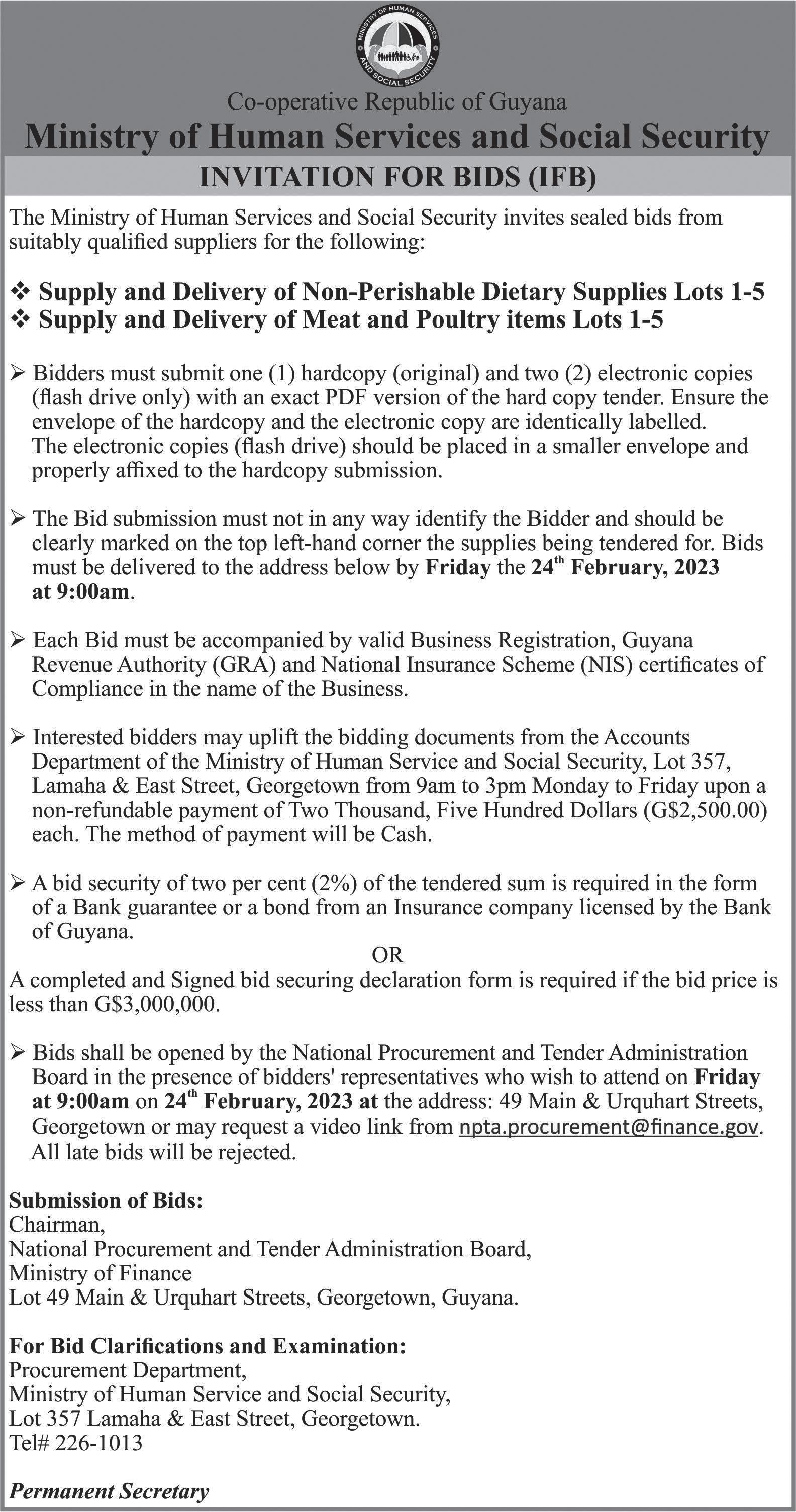



THE Georgetown American University (GAU) is primarily a medical school. It is owned and managed by Guyanese. It has a branch in the United States. Its faculty members are based both in the local jurisdiction and abroad.
The management of GAU is convinced that, if the Government’s Transformational Agenda is to be realised, every organisation – governmental and non-governmental – must play a meaningful role conscientiously. In this regard the Education Sector must take centre stage and GAU is prepared to continue to set the pace.
According to writers who specialise in education research, the on-the-job performance of graduates of a university is a fairly good indicator of the quality of the offering of that institution. The graduates of GAU, reportedly, have given the university good reason to be proud. But, according to a senior member of the management team at GAU, the university continues to seek
ways to enhance its pedagogy, especially during this digital age. If pedagogy is to be continuously improved, the curriculum has to be, from time to time, subjected to re-evaluation and lecturers have to be ‘retooled’. Relevant changes must always be considered and experts, when necessary, must be engaged.
A few months ago, the US Embassy, Guyana, made

a simple but significant contribution to GAU. Dr. Melissa Varswyk, Chief Executive Officer of GAU informed this publication that “The US Embassy, Guyana, shared an invitation for us to apply to the Fulbright Specialist Programme for an expert trainer in an area of interest. As we are addressing gaps in preparation for international accreditation, we applied for a scholar to assist faculty
development, especially in curriculum design and development.”
The Georgetown American University was successful in its application and the services of Professor Mark Ryan, a highly qualified educator, were acquired.
Professor Ryan engaged faculty members in both the
face-to-face and online (via ZOOM) modes. His presentations were very interactive.
Faculty members were even given the opportunity to ‘interrogate’ their respective courses and include elements that were being discussed.

Faculty members, especially the least experienced ones benefitted greatly from Pro-
fessor Ryan’s input. The management of the Georgetown American University looks forward to continued developmental/ institutional support from the US Embassy. Professor Ryan was indeed ‘GOOD NEWS’, a welcome contributor to the university’s own transformational agenda.
THE long-awaited St Rose’s High School in Georgetown is set to be completed by June, while re-construction of the North Ruimveldt Secondary school is scheduled to be completed by September, and work on the re-construction of the North West Secondary could be completed by the end of the year.
The Yarrowkabra Secondary is also slated to be completed in May, 2023, while the extensions on the St Winifred Secondary, and East Ruimveldt Secondary are also expected to be completed by June.
These timelines were shared by Minister of Education, Priya Manick -
chand, on Tuesday last, as she faced questions before the Committee of Supply during the examination of the Budget Estimates.
As she faced questions from Opposition member, Natasha Singh-Lewis about an allocation of $5.5 billion in the 2023 Budget for the construction of schools, Minister Manickchand reminded that the PPP/C government is left to complete a number of schools that the APNU+AFC left incomplete during their tenure.

“St Rose’s, you would recall, was demolished sometime around 2018 and never got rebuilt. We began to rebuild that and that’s going to be com -
pleted in June of this year. North Ruimveldt Multilateral was destroyed by fire in 2021. We began to rebuild that last year; it’s going to be completed this year by September. The North West Secondary school was destroyed by arson in 2021. We began to rebuild that and it’s go-
ing to be completed in 12 months, so that’s sometime at the end of this year,” Minister Manickchand explained.
The south block of the St Rose’s High on Church Street, South Cummingsburg was completely demolished in July 2018, after it was determined that
the structure had reached a state of disrepair, and all other options were exhausted.
Though a $352.7 million contract for the construction of a new building had been signed by the former Coalition government with Courtney Benn Contracting Services Limited in August 2018, the construction was plagued with delays, contract extensions, and increased contract price.
When the PPP/C took office in August 2020, that contract was terminated in November 2020, with the company having completed only nine per cent of the scheduled work.
A $515 million contract
to complete the school was then awarded to Shandong Degian International in September 2021. The project also has a consultancy firm, Kalitech Inc, which is supervising the quality and pace of ongoing works.
Construction on the North Ruimveldt and North West Secondary schools commenced last year, after the two were both destroyed by fire, in separate incidents.
Minister Manickchand also noted that the St George’s and Christ Church Secondary, which were also destroyed in respective fires, would also be rebuilt.


THE Guyana Civil Aviation Authority (GCAA) on Friday last celebrated its 56th year of membership with the International Civil Aviation Organisation (ICAO), even as the authority was lauded for its stellar work throughout the years.
At a commemoration ceremony which was held at the GCAA’s boardroom on High Street, Kingston, Minister within the Ministry of Public Works Deodat Indar commended the staff at the agency for their dedication that has driven the GCAA to have a very good track record.
On the occasion of its 56th year, Indar stated that the GCAA plays a pivotal part in Guyana’s ongoing transformation and development. As such, he expressed gratitude to the management and staff who have worked over the years to improve the standards of aviation in the country.
Indar, during his brief remarks, indicated, “The track record is progressive, it is developing year after year.”
Meanwhile, Director General of the GCAA, Lieutenant Colonel (ret’d), Egbert
Field, said that it was only in 2021 that the ICAO President remarked that Guyana was a shining light in the Caribbean, and early last year mentioned that Guyana is being used as a template for the

Caribbean region.
Against this backdrop, Field said that Guyana has steadily moved up the ranks of compliance in accordance with ICAO standards.
He revealed that at the
last audit, the country was adjudged at 77 per cent in compliance with the ICAO, while the global average was around 67 per cent. He noted that in 2022, the country was judged the number one state in relation to safety compliance in the Americas, which include Latin America, South and North America and Caribbean states. Further, the country stood at number two in relation to air-navigation services.
“That is what Guyana has been doing and thanks
to our ministers, as is said in aviation, it is often the political will that must be there in order to move aviation forward,” Field said.
He expressed gratitude for the level of support that the ministry has extended to the GCAA over the years. Meanwhile, recognising the strides that were made to move Guyana up the ranking, the agency on this occasion chose to honour 17 employees who have dedicated between 20 to 30 and more years to the GCAA.

IN the spirit of partnership and goodwill between Guyana and the United States, U.S. Ambassador to Guyana, Sarah-Ann Lynch has donated medical equipment and supplies to the Linden Hospital Complex in Region Ten.
The medical equipment, which includes adjustable hospital beds, diagnostic equipment, and patient-care kits, has a combined value of US$33,000, and was handed over to Minister of Health Dr. Frank Anthony on Friday.

This donation was made through the Department of Defense Overseas Humanitarian Assistance Program, and the United States Southern Command.
The equipment and supplies will support the Linden Hospital Complex in providing quality day-to-day care to patients locally in Linden and throughout Region 10 (Upper Demerara-Ber-
bice).
In her remarks, Ambassador Lynch reiterated the ongoing commitment the United States has to Guyana and its people.
“As Guyana works to make major advancements to its healthcare system and medical infrastructure in the nearterm, the United States Government is committed to the continued support of the people of Guyana, and our incredibly strong partnership. The United States is committed to promoting prosperity, inclusive for all of Guyana,” the diplomat was quoted as saying in a press release from the U.S Embassy on Saturday.
In response, Dr. Anthony noted, “This collaboration that we have with the U.S. Government has been a very long one, and more recently, during the pandemic, we have been able to enhance that collaboration.
“There have been many instances of how
we have been able to collaborate; this is just one of those opportunities where the U.S. Government has been working with the health sector to enhance the services we are able to deliver.”
According to the release, Region Ten’s Regional Chairman Derron Adams said in response, “I want to extend our
most sincere gratitude for the continued robust partnership between the US Embassy Team, the Linden Hospital Complex, and the office of the RDC.
“I assure you all that the RDC will continue to seek out and sustain opportunities like this one to bring much-needed services to the people of Region 10. We believe
that collaboration like this one will activate a process where our region, in the near future, can experience additional benefits developing and innovative strategies, like research for emerging technologies, software implementations, training etc. for all categories of healthcare workers, so that we can identify gaps
and opportunities.”
This latest donation is part of the United States’ ongoing partnership with Guyana’s health sector.
“The United States Government is proud to be a strong partner with the Government and people of Guyana in the fight against COVID 19,” the U.S Embassy noted.
The United States Government has donated 355,000 vaccine doses, and oxygen generators valued nearly US$500,000; provided five ultra-low refrigeration units for vaccine storage; medical supplies and other equipment valued at $300,000, and provided strengthened port health surveillance, laboratory reagents for COVID-19 testing, and technical assistance for outreach campaigns to encourage preventative habits, and overcome vaccine hesitancy valued at US$475,000.
PRIME Minister, Brigadier (Ret’d) Mark Phillips met with a team from the Jamaica National Group on Friday at his Office on Camp Street in Georgetown.

During the discussion, the delegation led by Mr Norton Taylor, Chairman of Enviro-Tech, briefed the senior government official on the company’s agenda in Guyana,
which includes investments in financial and technological services.
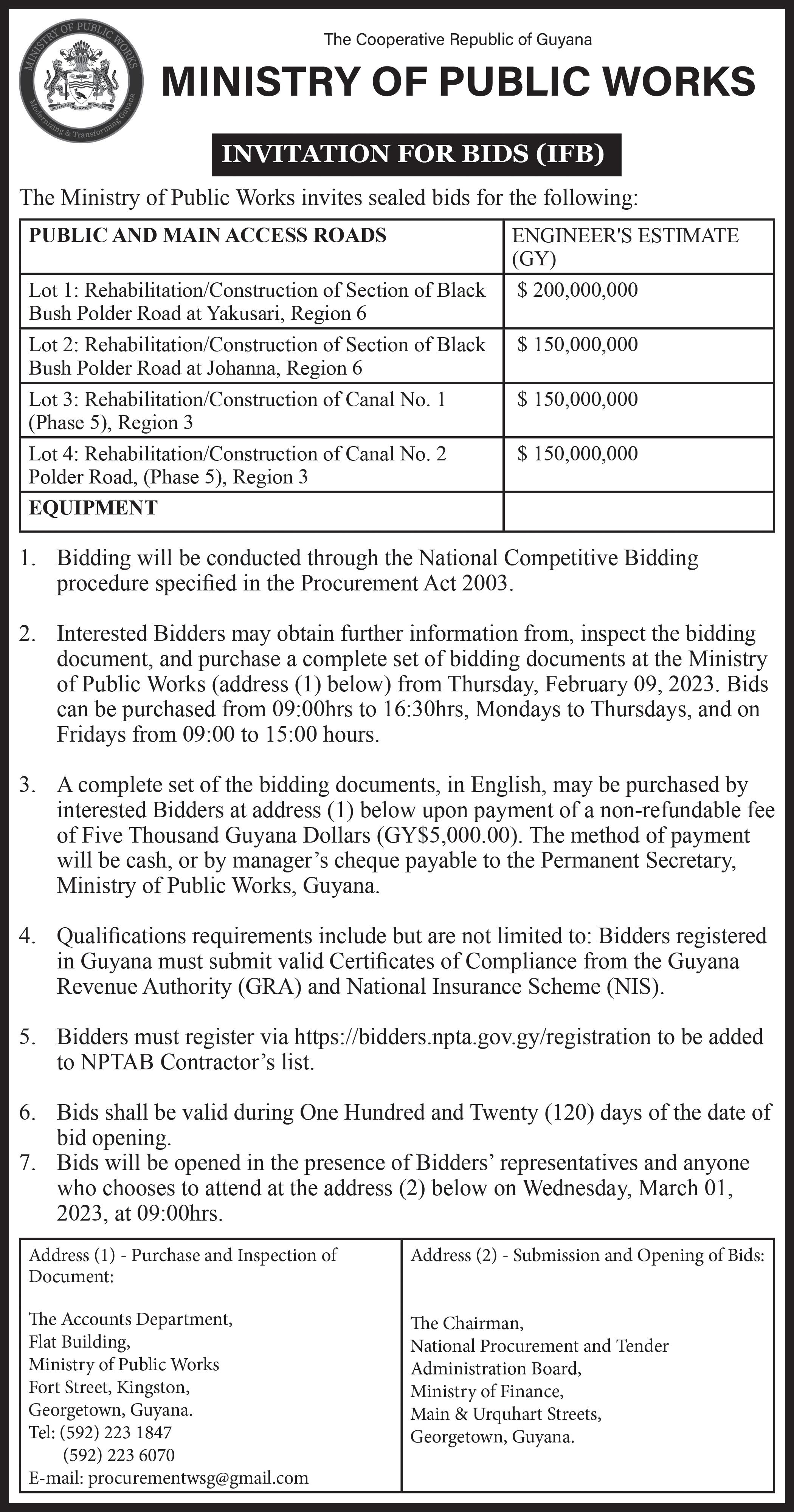
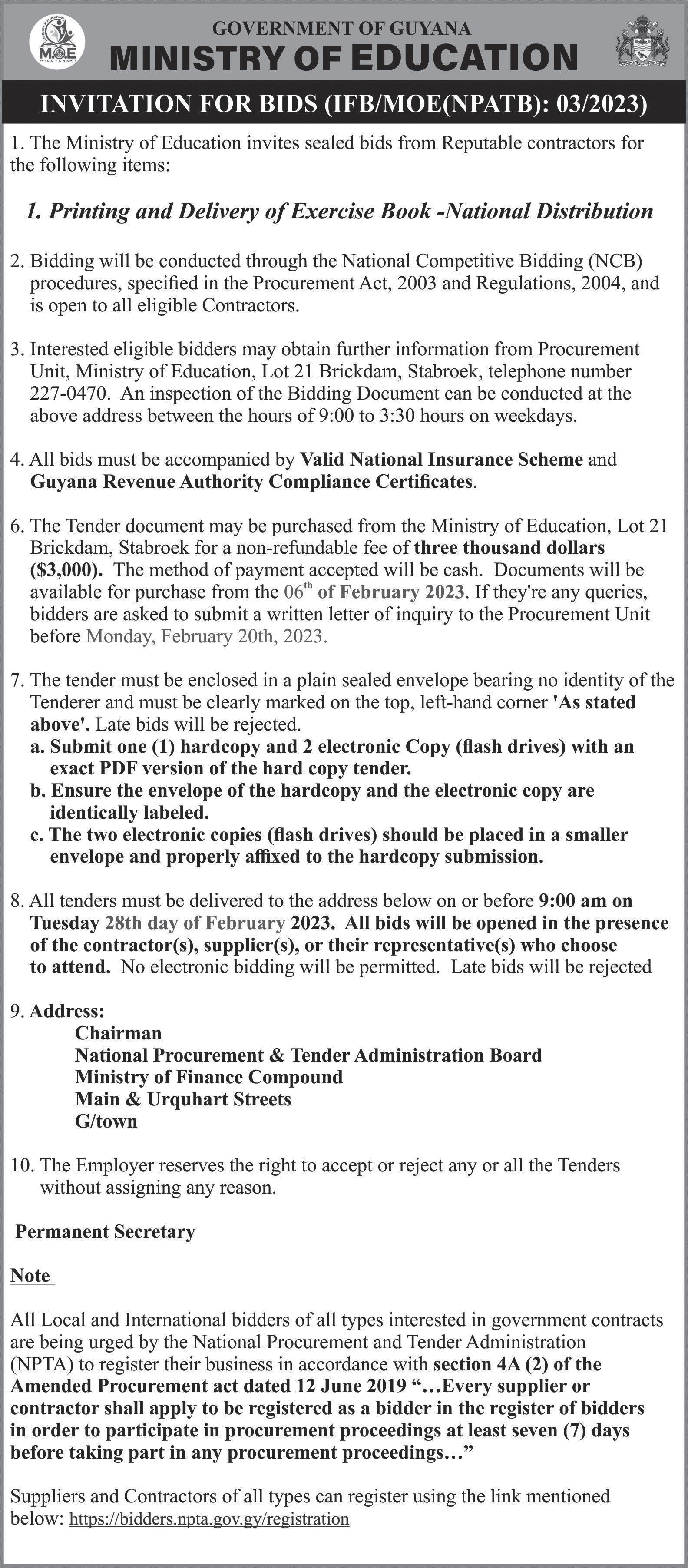
Prime Minister Phillips told the visiting delegation that Guyana welcomes interest from
other Caribbean countries and encouraged the group to look at all available opportunities.
“This is a good time to talk
about investments in Guyana and for Caribbean countries to invest in Guyana. What is happening in Guyana is not only
for Guyana, but it is a moment for CARICOM,” the prime minister noted.
General Manager of JN Money Service LTD, Mr Horace Hines; Chief Investment Officer of the Jamaica National Group, Mr Curtis Martin; Chief Executive Officer of Enviro-Tech, Mr Neil Taylor; Managing Director of Enviro-Tech, Ms Caryn Ramsden and Mr Eric Phillips were also at the meeting.
The Jamaica National Group comprises several world-leading entities which provide a wide array of financial, technological, creative and fleet-management services. (DPI)
Residents of Skeldon and surrounding areas can expect to benefit from a conducive space where they can relax, enjoy nature and bond with their families, friends and other members of the community, with the completion of the ‘Green space’ later this year.
The initiative is being executed through the Office of the First Lady and the Public Works Ministry at the Skeldon waterfront, and will offer persons the opportunity to connect with each other through increased quality time.


President, Dr. Mohamed Irfaan Ali, on Friday morning, during a visit to the location said, “As you can see, there is a more modern-looking style overlooking the water, there’s a utility building, there’s a huge fountain area, there’s a play area for kids, and the entire lawns will be manicured. We have seating accommodations for children and families out on the water.
“So, if you know what is happening in Windsor Forest, it’s a very simple project, but thousands of families, hundreds of children every single day go out there. And this is important in building communities, building stronger families, bringing people together and creating
that environment and that atmosphere in which cohesion, wellness, mental health—all can be addressed through these initiatives.”
He reminded that previously, the Skeldon waterfront site had been filled with unwanted waste, but through the beautification project, that waste has been removed, and the space was enhanced to improve the landscape.
“So, this is one. I just wanted to give an update. It will be well-lit, it will have adequate security, and this will no doubt enhance the entire area, and create another public space for children and families, and the community to enjoy,” Dr Ali stated.
He expressed his pleasure with the work being done at Skeldon, and noted that this and multiple other beautification projects are being completed through the involvement of the Men on Mission (MOM).

In October, First Lady, Mrs. Arya Ali officially launched the Skeldon beautification project, and a second in New Amsterdam, Region Six. The two projects cost $100 million each. The overall aim is to establish family-friendly recreational spaces in every region. (DPI)

WITH the aim of increasing agriculture production in Region Nine (Upper Takutu-Upper Essequibo), a budgetary allocation of $ 42.3 million has been approved by the National Assembly for the provision new cassava stems and additional planting materials.
As the National Assembly dissolved into the committee of supply on Wednesday last, Minister of Local Government and Regional Development, Nigel Dharamlall, said Region Nine will not be left out of the country’s development, as the budget has money for agriculture development initiatives, upgrading of electrical systems, and health facilities.
Meanwhile, providing further insight on the agriculture sector in the region, Agriculture Minister, Zulfikar Mustapha, said that several surveys and analyses have been conducted by the ministry to determine the needs of farmers in the region.

Seasonal flooding is said to occur when water from the Amazon Rainforest in Brazil travels through the Rio Negro River to the Brancho River and, eventually, makes its way to Region Nine.
However, the wet seasons for the past two years saw above-normal rainfall, resulting in the severe flooding which left many farms inundated for months; this resulted in many cassava roots being damaged.
“The ministry of agriculture has done extensive work in providing planting material, including cassava to the farmers of Region Nine. All the villages in Region Nine will be provided with planting material by mid-February,” Mustapha told the committee.
Further, the minister noted that several works have already commenced with the establishment of three agro-processing facilities
within the region.
This, he said, will help farmers in the region to add value to their produce.
“That region has been having a lot of development in the agriculture sector as a matter of fact we have three agro processing facilities to bring value to the farmers’ crops.
“In the deep south, St. Ignatius, we have tractors, we have grass planter, we have harrows to help plow to help those farmers there,” Mustapha added.
With the budgetary allocation, he said the region is slated for massive development in the agriculture sector to make a contribution to the country’s food security efforts.
Meanwhile, Minister Dharamlall emphasised that investments will not only be made in the agriculture sector of the region.
“We have agencies of government that provide direct support to the farmers… This government does not operate in silos,” the minister told the committee.
Further, $530 million has been allocated for the construction of roads, bridges and culverts and the upgrading of electrical and water supply systems, as part of the public works programme for the region.
The local government minister said, “We’re building roads where roads were never built. That is the mark of our government. We are also repairing roads that were left dilapidated for many years.”
Meanwhile, to improve access to health services in the region, two ambulances will be procured for the Lethem and Aishalton hospitals, as well as a lorry to assist in the distribution of drugs and medical supplies. Some $36 million has been allocated for this purpose.
The region has a total budgetary allocation of $4.8 billion.

THE Ministry of Housing and Water, through the Central Housing and Planning Authority (CHPA), will soon relocate 10 households occupying a government reserve at Bath, Region Five (Mahaica-Berbice) to pave the way for a new water treatment plant, which will benefit approximately 17,000 residents in the region from Number Seven Village to Kingelly.
According to a press release, Minister within the Ministry of Housing and Water, Susan Rodrigues, on Friday, engaged the informal settlers in the relocation process, as part of a follow-up to a meeting last year.

The families were assured by Minister Rodrigues that a humanitarian approach will be employed throughout the relocation and resettlement programme and that assistance will be provided for all persons.
“We will ensure that you get your house lots [and] we will ensure that we help you to settle somewhere you can be comfortable,” she said, urging residents to work with the ministry.
An inventory of the area was conducted in 2022. During Friday’s exercise, several persons were able to verify documents and those who were unable to register for house lots were allowed to initiate the process.
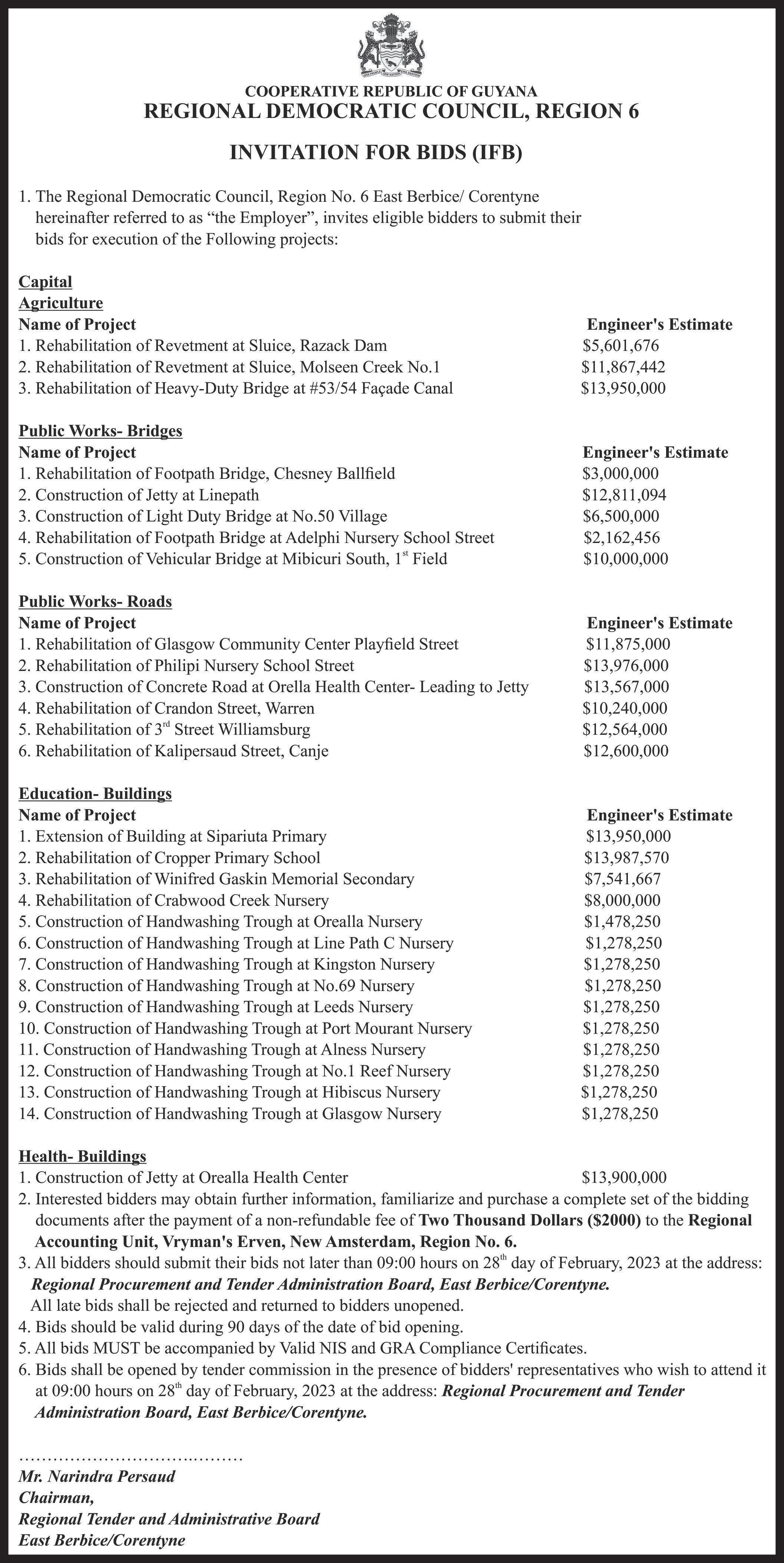
The minister outlined that as part of the government’s macro plan to push access to treated water on the coastland from 52 per cent to 90 per cent by 2025, 13 new water treatment plants will be constructed.
Contracts were awarded in 2022 for the construction of seven plants in Re-
gions Two (Pomeroon-Supenaam), Three (Essequibo Islands-West Demerara), and Four (Demerara-Mahaica).
In 2023, the construction of another six plants is expected to begin, including the one at Bath.
She further stated that funding has already been approved by the Caribbean Development Bank (CDB) and the ministry is working to prepare the sites and start the tendering process in the coming weeks.
Although the water treatment facility at Bath will initially provide service to at least 17,000 persons, its design will allow for expansion, in tandem with the government’s vision for the regional housing sector.
“Once we construct this treatment plant as well, it has the capacity to be built in a way, where we can even give access to more people, to over 24,000 people,” said Minister Rodrigues.
She added: “The region is growing tremendously and as we open more house lots and we open more areas, we have to ensure that we have the ability to expand so that everybody gets the same quality of water and development is moved at the same pace across all of the regions.”
The minister also met one-on-one with several other residents from the community on several housing and water issues. She was accompanied by Member of Parliament, Faizal Jaffarally; Regional Chairman, Vickchand Ramphal; and officials from the CHPA and the Guyana Water Incorporated (GWI).

residents who turned up at State House in New Amsterdam, on Thursday, to access the services provided by the Office of the President and several government agencies, have expressed satisfaction with the response to their issues and queries.

Throughout the first day of the two-day exercise, a number of persons flocked the Ministry of Housing and Water-Central Housing and Planning Authority booth for an update on their land applications and to raise other housing related matters.
The residents who spoke with the Guyana Chronicle said that they are now feeling a sense of relief having heard from the housing team and are eagerly awaiting a call to move forward with the process.

Bhojnarine Gossai and his wife Samantha Gossai, of Ferry Street, New Amsterdam, said they are looking for stability for their family as they have moved five times in the last four years and in less than three weeks they will have to find a new place to live.
After learning that President, Dr. Irfaan Ali was holding an outreach, Gossai and his wife decided they were going to use the opportunity to share their plight and inquire about the status of their house lot application.
Following a quick check by the housing officials, the couple who are parents to two children, ages four and six, were told to expect a call on Monday.
They were all smiles as they are on the verge of finally getting their own land on which they will construct their home.
“The persons we staying by want the place by February month end so when I get through with this house lot it would mean the world to me. Me and my family would finally have peace and
be stable. I can’t wait,” a beaming Gossai said.
Gossai who is a cane harvester at the Blairmont Estate, told this publication that he was happy that an initiative of that nature was being done in the region since it offered persons direct access to relevant personnel who can make on-the-spot decisions.
He added that he made the right choice to attend the outreach.
Meanwhile, Nafeeza Kumar, 43 of Winkle Road, New Amsterdam explained that after meeting with representatives from the Central Housing and Planning Authority, she was delighted to get “positive news”.
Kumar related that she was presently renting and was eager to know the status of her land application which was submitted in 2016.
The woman told this publication that from then to now she had repeatedly called the agency for a status update.
She said that she was told that she needed to wait.
At the outreach, she said she was told of a proposed piece of land at Number 76 Village, Corriverton. She should be receiving a call from the agency next Thursday or Friday. “I
checking and all I was hearing is I had to wait, but today I am extremely glad to know something is happening and I would get through. I want to say thanks to the ministry and to the government for reaching to us on the ground, this is commendable and I am glad I come out here today,” she added.
Further, New Amsterdam resident, Simone Clement, was among the hundreds of residents who attended the outreach.
“It really is a good thing the president is here to deal with everything, but housing out here is really commendable and helpful. You really do get your issues heard and I really hope and pray to get my land soon. I appreciate all the help I had today as I look forward to a call soon.”
In addition to land allocations, several other housing related issues were addressed. Chief Executive Officer of CHPA, Sherwyn Greaves, was on the ground listening directly to the concerns of residents.
President Ali, on Thursday, delivered on two promises. One was to a former sugar worker who was still awaiting his severance pay and the other concerned two
farmers who had requested fertiliser and other support.
According to the Department of Public Information (DPI), Paul Tyndell walked away extremely happy after receiving some $250,000 as severance payment. He lost his job when the former APNU+AFC Government shut down operations at four sugar estates.

The 54-year-old man received his cheque from President Ali minutes after he raised the issue.
“I feel happy to know that we have a president not on promise; he is on time, and he speaks his words and it come to pass. I believe that’s what the people need, a man with a vision. One who speaks words and it come to pass,” the father of five explained.
He also expressed thanks to the Minister of Agriculture, Zulfikar Mustapha, noting that he too contributed to investigating the issue.
The DPI said that the president also came in for high commendation when he provided a sufficient quantity of fertilisers to two farmers in less than 30 minutes. The two are cultivating lands at Highbury, along the East Bank of Berbice.

Sean Grant told DPI that he currently has 675 mature trees including
mostly lemons and 160 soursop trees under cultivation.
Grant approached Dr Ali requesting fertiliser support and assistance with cleaning of a drain that is in close proximity to his farmland.
“It was handled and resolved efficiently, and definitely to my satisfaction. We received five bags and we were promised that within a week we will get a date for the cleaning of the 1,000 rods of drains,” the man told DPI.
He said the importance of President Ali’s strategy of meeting the people at the grass root level cannot be overstated.
The president relocated his office to Berbice for the two-day exercise so that he could listen to the concerns of
residents, with the aim of finding immediate solutions.
Representatives from a number of government ministries and agencies accompanied him.
“The unique exercise provided an opportunity for leaders to get first-hand feedback from those they serve, allowing them to make informed decisions that address the needs of their constituents. The president believes that this type of interaction also promotes transparency and accountability, as residents are given the opportunity to hold their leaders accountable for the promises made to them,” DPI said.
— say housing issues, other matters were adequately addressedChief Executive Officer of the Central Housing and Planning Authority, Sherwyn Greaves, and his team listen to the concerns of a Region Six resident Paul Tyndell (DPI photo) Sean Grant (DPI photo) A quantity of fertilisers were handed over to two farmers in keeping with a commitment made by President Ali (DPI photo)




THE oil and gas sector in Guyana has seen rapid development and growth in a short period of time. To ensure development stays on track for projects, efforts have been made by Guyana and its partners to prioritise safe drilling and sustainable development.
Earlier last week, it was announced that the Payara project will be utilising a floating production, storage and offloading (FPSO) vessel with a record sustainable design. Prosperity will be the second FPSO to operate offshore Guyana with this new design, after Liza Unity being the first.
The Liza Unity design was also the first production vessel of its kind in the world to be awarded the SUSTAIN-1 notation by the
Classification Society American Bureau of Shipping (ABS).
Making FPSOs more sustainable includes the adoption of new or redesigned technologies, better methods to generate electricity to power onboard equipment and regulated guidance on venting among other areas.
The new vessels are expected to be more energy efficient and have lower air emissions than any other similar vessels operating around the world. Like Unity, Prosperity is likely to be awarded the SUSTAIN-1 notation by the Classification Society American Bureau of Shipping (ABS), making Guyana a leader in this space.
In keeping with Guyana’s desire to maintain its green identity, much thought has
been put into ensuring the most modern and sustainable vessels will operate offshore.
Sustainable design, while often overlooked, will be a critical element of the role Guyana plays in helping the world meet energy needs, while still balancing a diversifying energy mix. Guyana and its partners are already doing impressive work to ensure projects are meeting high environmental standards, while still prioritising production.
President Irfaan Ali shared his vision for how sustainability fits within Guyana’s future at a Wilson Center event in July 2022.
“You will see in our development strategy, whether it’s the food strategy, the oil and gas strategy, the infrastructure strategy… a full
commitment to ensuring that our forest remains intact, remains sustainable,” President Ali said.
“We have a monitoring system that is of international standard. We have audits. So, the development part of Guyana is a part that reaches towards sustainability, is a part that is diversified. And that is why these forums are critically important for us – ensuring that the world and investors, people in academia and policy makers, understand the wide-ranging multi-faceted nature of development and the path of development we are taking to position Guyana as a sustainable story in our development phase,” the Head of State related.
President Ali reinforced that sustainability is an integral part of Guyana’s future
as it develops its resources. This is important as Guyana continues to provide the world with a reliable source of energy, while simultaneously developing its economy and putting in place strategies like the Low Carbon Development Strategy 2030 to ensure a secure energy transition.
Last year, ExxonMobil announced that there could be as many as ten floating production storage and offloading vessels (FPSOs) operating offshore in Guyana. More importantly, whether it be the new Prosperity FPSO or the others expected to be developed in this decade, the government has a plan to monitor the impact of these vessels.
Last week, the Environmental Protection Agency an-
nounced it will contract with Maxar Technologies Inc. in Colorado for real-time environmental monitoring, using satellites to spot oil spills in real time both onshore and offshore.

Environmental standards and record production numbers are not mutually exclusive in Guyana, and only further demonstrates the foundational importance of investing in sustainable design in the oil and gas sector.
Continuing on the right path will require ongoing careful consideration of all the factors necessary to strike the balance between high environmental standards, industry competitiveness through production, and transparent processes that benefit the country.
SHERIFF Security and Medical Services continues to capitalise and expand its investments in Guyana’s economy with the purchase of the first of its kind Bell 505 Chopper at a cost of US$1.9 million.
Proprietor, Ameir Ahmad, said the chopper was purchased from the Bell Helicopter Factory in Texas, United States of America.
During an interview with the Sunday Chronicle, Ahmad explained that the idea of getting a chopper has been “a long time in the making.” According to him, he takes pride in knowing that it is the “first private helicopter license that has been given and fully approved by both Bell and now the Government of Guyana.”

He said the Bell 505 Chopper will be to shuttle company officials from the city of Georgetown to the new investment site in Berbice. Taking into
consideration the traffic situation across the country, Ahmad said it will help tremendously since he will be able to visit the locations in a timely manner.
“This goes to show the rate at which Guyana is developing; companies like ours can invest in
brand new aircraft, machinery, and equipment knowing that we are investing in an economy that will benefit us all as Guyanese and it is an exciting time for us all.
“I am happy that we are contributing to Guyana’s economy through our security services, our medical facilities and our other investments,” the businessman said.
The Sheriff Group of Companies has made a commitment to invest over US$75 million in Palmyra, Berbice, Region Six (East Berbice-Corentyne).
The massive investment is inclusive of a 150-room Sheriff General Hospital, which will be a specialty hospital that will be performing heart surgeries, eye surgeries and cancer treatment, among other medical procedures. The procedures that will be done at the new hospital will also complement those at the other hospitals.
Ahmad had noted that the company realised that
private institutions in Berbice are limited and so, the aim is now to revolutionise the Berbice region.
Meanwhile, Sanjiv Birsen, representative of Tropical Aviation Distributors - based in Miami – told this newspaper that the company is the only authorised distributor for the Bell helicopter, Textron Aviation Systems and Thrush agricultural aircraft in Guyana.
“We have been working in Guyana for almost 40 years now and over the past six months, we have been working with Sheriff
to put together a Bell 505 package that will be safe, secure and effective for the purpose of moving to and from his destination.
“It will be the first in the country and it will contribute to Guyana’s medical field growing even further, as well as helping the Sheriff Firm grow even more from where they are right now.”
But what makes the Bell 505 Chopper unique among the others?
“Right now, the Bell 505 is our newest platform out there and it is the most technologically advanced
single-light helicopter that’s out there. It comes with a full glass cockpit, a G1000 cockpit, turban power and the latest and greatest aviation that we have.
“The other great thing about the aircraft is, it’s very economical to operate, has a low cost, but still has high safety measures.”
The first of its kind, the Bell 505, is set to arrive in Guyana within the next 60 days.

Meanwhile, Ahmad explained that Sheriff Security and Medical Services aims to provide security and medical facilities in every region of Guyana in the very near future.
“Sheriff Security and our medical facilities have tremendous growth and it’s simply because we do the right thing. That is, we train our staff, we pay them well and we ensured that their NIS and benefits are met. We are going to grow. What I can tell you right now is that by April, we will provide security countrywide, from Region One to Region 10.”
‘Sheriff’ aims to provide security,
— invests in US$1.9M helicopterThe first of its kind Bell 505 Chopper was purchased at a cost of US$1.9 million Proprietor of Sheriff Security and Medical Services, Ameir Ahmad

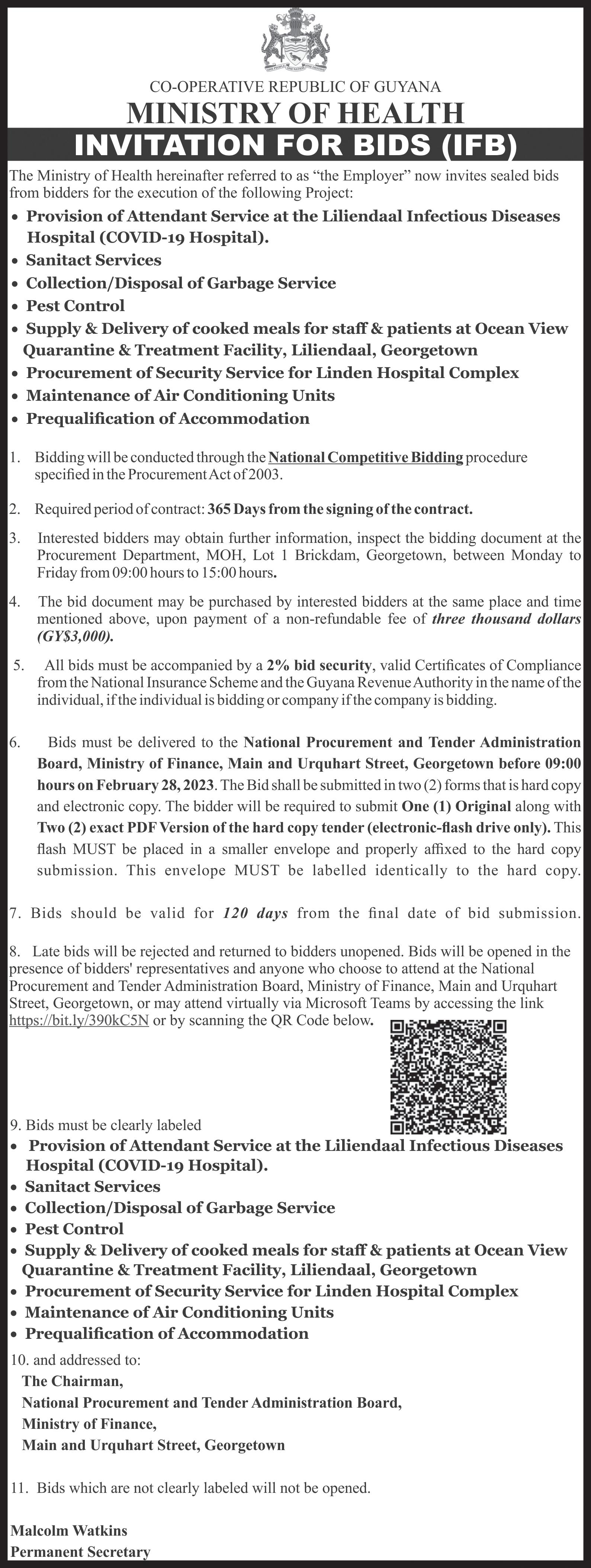
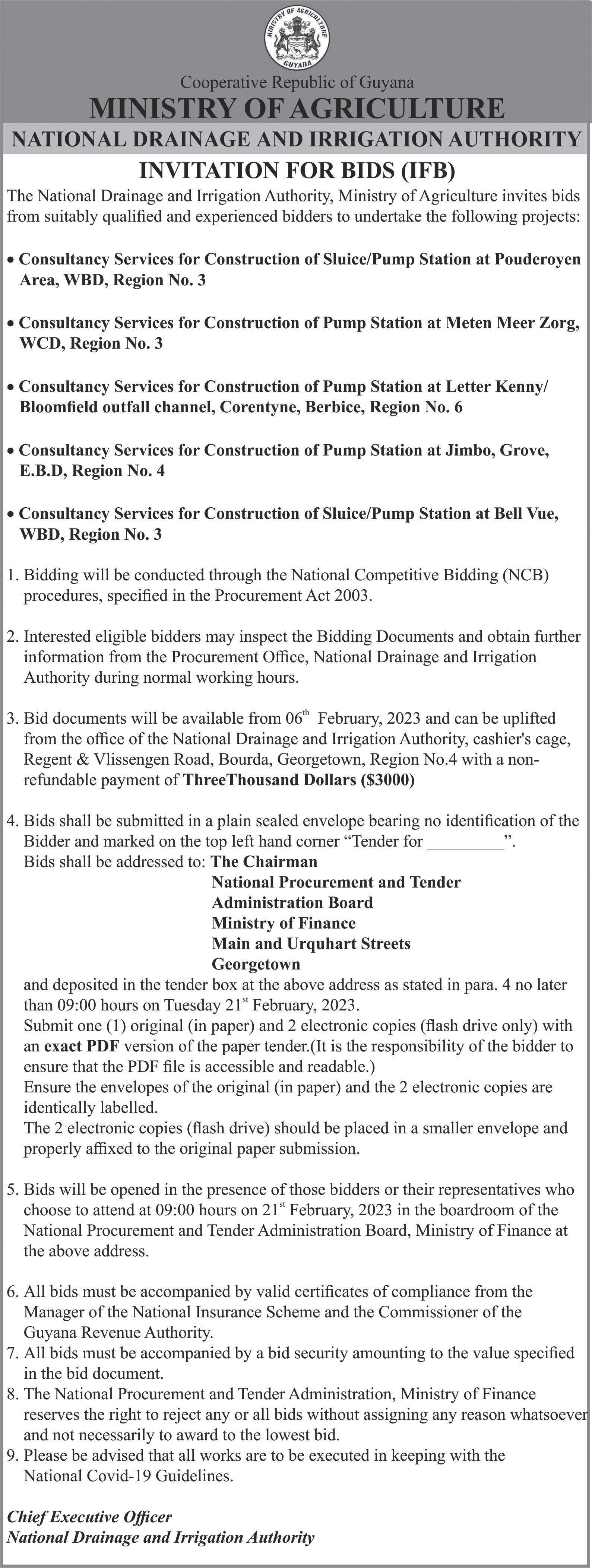


IT has been almost 100 years since the first woman of colour appeared on the “big screen.’ And though she did so in 1929, Nina Mae McKinney remained in relative obscurity until last year, 55 years after her death, when New York’s Film Forum mounted a three-week retrospective on the nearly 20 films the actress made in the course of her career.
Following in the footsteps of this woman, who has been described as “one of the most dynamic actresses to ever grace the screen,” is our very own Letitia Wright – humble and gifted – who we all proudly welcomed back home two weeks ago.
The 29-year-old Guyanese-British Actress, who received an Honorary Doctorate from the University of Guyana and the Key to the City from the Mayor of Georgetown, during her whirlwind visit, began her career 10 years ago.

She has been the recipient of several prestigious awards, including the NAACP Image and BAFTA Rising Star Awards, but was catapulted to fame for her portrayal of Shuri in the cinematic blockbuster – Black Panther:Wakanda Forever.
However, the journey of Black women in the movie world has been neither rapid nor easy. In fact, both male and female Black actors have had to surmount seemingly impossible odds to achieve acceptance in a white male-dominated industry.
Perhaps the greatest battle Black women in film have fought is against being cast in stereotypical roles, which has been the case for the better part of half a century.
In his article on the subject, scholar, Edward Mapp, refers to “the steady procession of mammies, maids, matriarchs, madams and assorted “make-it-for-money” types, which were the only roles available to Black women.
Nina Mae McKinney was cast in the role of temptress in her ground-breaking appearance in the black musical ‘Hallelujah,’ in which she seduced a poor Black cotton picker, relieving him of his cash, while another Black actress, Dorothy Dandridge, is known to have built her career on such roles.
She achieved limited success when she was nominated for an Academy Award as best actress in a leading role, for her performance in Carmen Jones in 1954. But instead of “opening doors” for her, the nomination resulted in the actress being sidelined and treated as if she did not belong in the industry.
And when McKinney died
in 1967, her death certificate listed her as “widowed” and a “domestic servant,” though she fought against being cast in the latter role during the course of her career.
It is ironic too that she and the other light-skinned actresses like Dandridge and Lena Horne, were able to get the parts of leading ladies denied to other dark-skinned women.
The “colourism” in Hollywood was further compounded in movies like “Imitation of Life” and Showboat, where the leading Black characters sought to hide their roots and attempted to “pass” as white because of their fair skin.
As writer, Mapp, put it” “The sexual dimension of American racism is reflected in the motion picture portrayal of the Black woman. Her film image has been defined by others rather than by herself.”
It was not until pioneering African American producers, directors and screenwriters began to make their presence felt in the late 1900s that Black actors and actresses were given roles with positive images, shown primarily to Black audiences.
Filmmakers like Zora Neale Hurston, Tessie Souders and Eloise Cist rebuked Hollywood for its bias, while actresses like Evelyn Preer and Fredi Washington began acting in independent Black films offering a greater variety of roles.
Many of these names are little known outside of the industry, but their persistence and determination forced Hollywood to relent and slowly begin to allow talented Black actresses a chance to appear on screen in roles which allowed
them to showcase their skill, intelligence and wit.
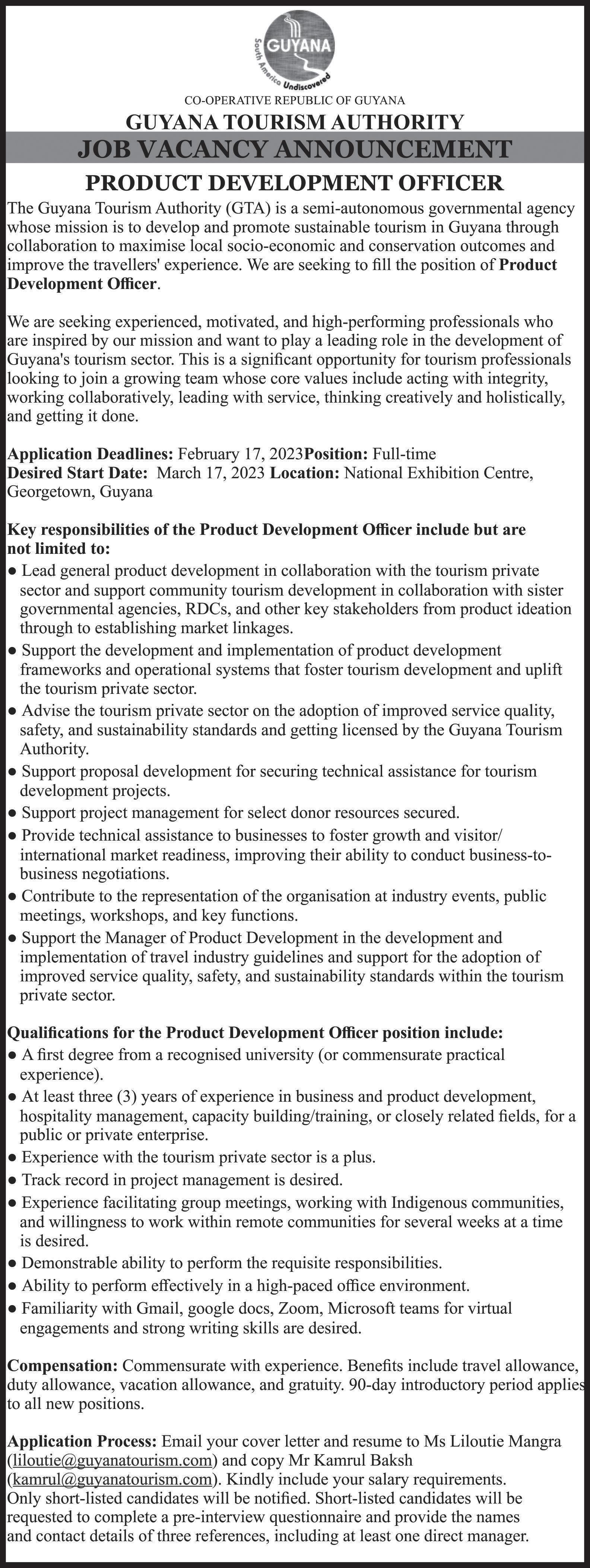
Yet, although Hattie McDaniel was the first African-American woman to win an Oscar for Best Supporting Actress back in 1939, it took until 2002 for a black actress, Halle Berry, to receive an Academy Award for Best Leading Actress and she remains the only one to have done so to date.
However, while women of colour seem to have been relegated to the position of only being credited with awards for supporting roles, a string of actresses, like Oprah Winfrey, Whoopi Goldberg, Cicely Tyson, Viola Davis and Angela Bassett have turned in performances worthy of the highest accolade and have made an indelible mark on the industry, paving the way for others like Letitia Wright.
In an interview locally, the actress, who has herself been faced with challenges on her way to stardom, said: “The industry is not to play with… you can get lost in it.”
Referring to her homecoming as “beautiful” and “overwhelming,” she spoke freely of a faith in God, which has kept her grounded and which she credits for her successful career and achievement in Wakanda – receiving the Screen Actors Guild award for Outstanding Performance by a Cast in a Motion Picture.
I am sure I speak on behalf of all Guyanese when I wish Ms. Wright continued success in her career and even more inspiring roles on the “big screen,” and here’s hoping she visits us again in the not-too-distant future.




FROM BACK PAGE
him, and I am confident he will do superb things for West Indies.”
They became only the 10th Windies opening pair to feature in two century partnerships in Tests after they forged a new alliance on the Tour of Australia before Christmas last year – and it is the third time they have shared 50-plus in five innings.
Though the durability of the West Indies opening pair in this innings will not be questioned, their slow accumulation of runs in an era when scoring rates in Tests have increased significantly
meant the Zimbabweans felt little pressure.
Brathwaite needed 116 balls to reach his 50 when he drove pacer Victor Nyauchi through mid-off for three in the final over before the refreshments break in the second session of play.
Chanderpaul, son of former Guyana and Windies captain Shivnarine Chanderpaul, took 165 balls to arrive at the landmark with a confident pull through mid-wicket off left-arm pacer Richard Ngarava, for the seventh of his eight boundaries in the penultimate over before the rain stoppage.
There were few strokes of genuine attraction from the West Indies opening pair, but Chanderpaul smacked a nice back-foot cover drive off pacer Bradley Evans for four to break the shackles in the first over after the Caribbean side resumed from 54 without loss at lunch.
It was a strong response after he had come close to being dismissed off the previous delivery when he essayed an ill-advised hook at a short ball from Evans, and he was fortunate that leaping wicketkeeper Tafadzwa Tsiga was not able to get a mitt to the ball.
FROM BACK PAGE

sored by Team Mohamed’s.
The team finishing third will pocket $100,000.
Toney said the tournament was conceptualised as an avenue to resuscitate the discipline, adding that the resulting success has morphed into a national event which is a major highlight of the sports calendar.
According to Toney, the tournament’s importance is unquestioned as several players have represented Guyana at the 3x3 AmeriCup Championship in the United States.
Toney further stated that he takes pride in pioneering the only senior 3x3 tournament in Guyana, noting
that the success of the event could not have been realised without the unwavering support of the sponsors.

Team Mohamed’s, Hennessy, E-Net, VSH Shipping, Slingerz Entertainment, Shi-Oil and Hot Spot Bar are listed as some of the sponsors.
Chanderpaul, on 37, also turned a delivery from leg-spinner Brandon Mavuta dangerously close to the forward short leg fielder.
Perhaps, he sensed the weather was going to change, and with the half-century mark beckoning, he came out of his cocoon with successive boundaries in Mavuta’s fifth over, and another pair in Nagarava’s ninth over to race to a career-best score.
Brathwaite also appeared to enjoy a chunk of good fortune when he played back and across to a delivery from Mavuta in the final over before the rain arrived, and
he was struck in front, but umpire Reiffel turned down the lbw appeal of the hosts.
TV replays were inconclusive, and the ball tracking technology typically in operation to review the decisions of umpires in such circumstances is not in use for this series.
West Indies, who have not lost any of their previous 10 Tests against Zimbabwe, omitted Nkrumah Bonner, Devon Thomas, Shannon Gabriel, and Jomel Warrican from their final 11.
The second Test in the series starts on Sunday, February 12.
a frustrating ninth wicket stand of 36 before off-spinner Chaim Holder bowled the left-arm spinner to prompt the declaration.
Pride endured an early setback when left-handed opener Shayne Moseley was caught behind for a duck off Smith in the second over, and they were wobbling on nine for two when pacer Shamar Joseph trapped Zachary McCaskie lbw for four in the next over.
Pride were 11 for two at lunch, and Beaton and Permaul combined to carve up their middle order, ensuring there was to be no
comeback story.
After Brooks defied with Drakes for an hour, Beaton had him caught at gully, and triggered a slump in which four wickets fell for eight in the span of 28 balls – including the scalps of Nicholas Kirton, Shamar Springer, and Pride captain Shane Dowrich, all for ducks.
Smith returned to clean up the tail and formalised the result when he got Keon Harding caught at gully for seven, and two balls later, he bowled newcomer Jair McAllister for four.
Bramble b Smith
J. Drakes c Permaul b Smith
S. Brooks c (sub) b Beaton
N. Kirton c wk Bramble b Permaul
S. Springer c wk Bramble b Permaul
*+S. Dowrich c Johnson b Beaton
A. Jordan c Sinclair b Smith
C. Holder not out
K. Harding c Sinclair b Smith
J. McAllister b Smith
Extras (b1, lb2,nb2)
TOTAL (all out, 36 overs) 94
Fall of wickets: 1-5,
(nb1); Beaton 8-4-11-2; Permaul 8-1-18-2; Sinclair 3-0-10-0.
UP to 40 countries could boycott the next Olympic Games, making the whole event pointless, said Poland's sport and tourism minister Kamil Bortniczuk. His comments came after Poland, Lithuania, Estonia and Latvia jointly rejected an International Olympic Committee (IOC) plan to allow Russians and Belarusians to compete in 2024.
Ukraine has threatened to boycott the Paris Olympics if that occurs.
But the IOC said on Thursday that any boycott would only "punish athletes".
Bortniczuk said he believed it would be possible to build a coalition of 40 countries, including Great Britain, the United States and Canada, to support a block on the International Olympic
Committee's plans before a meeting on 10 February.
He added: "Considering this I don't think we will face tough decisions before the Olympics and, if we were to boycott the Games, the coalition we will be a part of will be broad enough to make
holding the Games pointless."
The IOC announced last week that it would "explore a pathway" to allow Russian and Belarusian athletes to compete in Paris under a neutral flag, adding that "no athlete should be prevented from competing just because

PERTH Scorchers won the Big Bash for the fifth time with a thrilling five-wicket victory over Brisbane Heat.
Nick Hobson hit a six and a four in successive balls as the Scorchers chased down their target of 176 with just four balls to spare in Perth.
A half-century from Ashton Turner and a lively cameo from Cooper Connolly helped set the platform for the win.
(Scores): Brisbane Heat 175-7 (20 overs): McSweeney 41 (37), Heazlett 34 (30),
Bryant 31 (14); Behrendorff
2-26
Perth Scorchers 178-5 (19.2 overs): Turner 53 (32), Inglis 26 (22), Connolly 25no (11)
Nathan McSweeney earlier top-scored with 41 for the Heat as they posted 175-7
of their passport".
The move prompted condemnation, with the UK Government saying the plan was a "world away from the reality of war".
Ukraine sports minister Vadym Guttsait said the country's sporting bodies needed to "strengthen communication" with international federations to keep a ban in place on Russian and Belarusian athletes, which was imposed by the IOC's executive committee immediately after Russia's invasion of Ukraine in February 2022.
However, IOC president Thomas Bach has since said that was only intended as a "protective" measure towards those athletes, and now insists they should not be discriminated against.
On Thursday, sports min-
isters from Latvia, Lithuania, Estonia and Poland said "any effort by the International Olympic Committee to bring back Russian and Belarusian athletes to compete, even under a neutral flag, should be rejected".

They added: "Efforts to return Russian and Belarusian athletes to international sports competitions under the veil of neutrality legitimize political decisions and widespread propaganda of these countries."
And they called on "all international sports organisations and federations" to remove Russian and Belarusians athletes from international competitions until the war ends.
The IOC reiterated that no discussions on the return of Russian and Belarusian
athletes to competition had yet taken place and warned Ukraine and other nations about the implications of threatening a boycott.
"Threatening a boycott of the Olympic Games, which the NOC of Ukraine is currently considering, goes against the fundamentals of the Olympic movement and the principles it stands for," the IOC wrote in a question-and-answer document published on Thursday."A boycott is a violation of the Olympic charter, which obliges all NOCs to 'participate in the Games of the Olympiad by sending athletes'. As history has shown, previous boycotts did not achieve their political ends and served only to punish the athletes of the boycotting NOCs.
from their 20 overs.
The Scorchers, who were the defending champions, went into the game as favourites after topping the table and having beaten Brisbane Heat in both meetings during the regular season.
In contrast, the Heat
were bottom of the table in mid-January but three wins from their final four games took them to fifth, before they came through three knockout games to reach their first final since 2013.
After the Heat won the toss and chose to bat, McSweeney anchored their innings, putting on 79 for the second wicket with Sam Heazlett.
Their momentum was checked by the loss of three wickets for 13 runs, but Max Bryant's lively 31 from 14 balls and and unbeaten 21 from 16 from Warwickshire's Sam Hain lifted them up to a competitive score.
The Scorchers were reduced to 54-3 early in their reply, but then Turner, who hit 53 from 32, and Josh Inglis (26 from 22) put on 80 for the fourth wicket.
The game swung the Heat's way again when they both fell in quick succession, but some incredible power hitting from Hobson and teenager Connolly, who smashed 25 from just 11 balls, took them over the line.
5,000m and 10,000m champion Sifan Hassan says she is ready to take a "step into the unknown" when she takes on the 2023 London Marathon.

The Dutch athlete, who also won Olympic 1500m bronze in Tokyo, will come up against a trio of world record holders in her marathon debut on 23 April.
But she will still also target a summer track season as she considers her plans for the next Olympics in Paris in 2024.
"I'm a curious person," said the 30-year-old Hassan.
"I don't know if I can be great at the marathon or not. Even the distance is so challenging," she added.
"It's different. I will dream about [targets] after I even finish the distance [in training]."
Hassan, only the second woman to complete an Olympic distance double, will come up against a world-class field in London which also includes Kenya's marathon record holder Brigid Kosgei and Olympic marathon champion Peres Jepchirchir.
Genzebe Dibaba, owner of the 1500m record, will
also line up alongside fellow Ethiopian and 2022 winner Yalemzerf Yehualaw.
The 23-year-old Yehualaw, who set a 10K world record in February 2022, ran the third fastest women's London Marathon time in history to win in two hours, 17 minutes and 26 seconds last year.
Eilish McColgan will make her marathon debut in the 2023 race.
"Before I can make a final decision on which direction to go, I need to test myself over the marathon distance," said Hassan.
"It will be a step into the unknown in many ways for me but I'm looking forward to it."
Britain's Commonwealth Games 10,000m champion
Ethiopian Kenenisa Bekele is among four of the five fastest runners in history announced in the London Marathon's elite men's field, which will also see British four-time Olympic track champion Mo Farah say an "emotional goodbye" to his home support.
The London Marathon returns to its pre-pandemic spring slot in 2023 for the first time in three years and will be broadcast live on BBC TV, iPlayer and online
Sifan Hassan ready to ‘step into the unknown’Sifan Hassan has won global titles over 1500m, 5,000m and 10,000m on the track.
perts and operatives, as well as experienced sports administrators and aficionados. The group will be meeting next week to commence the process, which will be thorough to ensure any inadequacies are remedied.
cess is not only transparent but can stand up to the highest level of scrutiny and examination on the local and international scene. The importance of the selection criteria must be reflected. That narrative must never be called into question.”
“Ultimately, this assessment process is about possi-
bly enhancing and amending the rules that are employed for selection, if deficiencies are recognised. Some areas for analysis have already been earmarked by the panel, and discourse will occur on the way forward if amendments are required. There is no point in waiting until next year to undertake
 Charles Ramson Jr.
Charles Ramson Jr.
THE National Sports Awards returned this year to much fanfare after an elongated hiatus due to the covid-19 pandemic.
The National Sports Commission (NSC) has decided to build on what they have and hence, a ‘review exercise’ will be implemented to analyse the overall criterion utilised for selection of the recipients of the National Sports Awards.
Director of Sport, Steve Ninvalle, stated that the assessment procedure will be undertaken by a high caliber panel comprising media ex-
According to Ninvalle, “The panel, which is of the highest competence, and is littered with media experts and sports enthusiasts, will be meeting next week to analyse the entirety of the selection criteria and will make recommendations, if shortcomings are identified, for possible amendments.”
“The objective is to ensure that the selection pro-
COOLIDGE, Antigua, (CMC) – Leeward Islands
Hurricanes drew with Jamaica Scorpions on the final day of their first round match in the West Indies Championship on Saturday at the Coolidge Cricket Ground.
Scores:
LEEWARD ISLANDS
HURRICANES 260 (Jeremiah Louis 78 not out, Jahmar Hamilton 40, Montcin Hodge 37, Rahkeem Cornwall 29; Marquino Mindley 3-28, Abhijai Mansingh 3-47) and 241 (Rahkeem Cornwall 85,
Montcin Hodge 31, Kieran Powell 28, Keacy Carty
26, Hayden Walsh Jr 23; Jamie Merchant 4-43, Abhijai Mansingh 2-30, Patrick Harty 2-56).
JAMAICA SCORPI -
ONS 234 (Leroy Lugg
79, Abhijai Mansingh 56, Paul Palmer 47; Rahkeem Cornwall 28-10-545, Sheeno Berridge 2-25, Coln Archibald 2-37) and 199 for nine (Abhijai Mansingh 62, Jamie Merchant 47, Kirk McKenzie 28, Romaine Morris 22; Rahkeem Cornwall 3015-41-5)
the procedure, which can be reinforced now ahead of the next awards ceremony. This exercise will encompass the entirety of the National Sports Award selection platform”, Ninvalle further explained.
Meanwhile, Ninvalle explained that Minister of Culture, Youth and
Sport, Charles Ramson Jr., who applauded the work undertaken by the panel during the 2022 National Sports Awards, has disclosed that the impending edition will be completely overhauled and upgraded to reflect his vision of a gala and red carpet affair.
WATCHED by a large and raucous gathering with Reggie songs being played by Ras Camo’s Steel Pans, the atmosphere was absolutely fantastic at the Georgetown Club for the semi-finals of the BCQS Masters Squash Championships on Friday night.
The semi-finals in the Men’s 30-44 age group were the most entertaining matches on the penultimate night as former national champion Alex Arjoon beat Daniel Ince in a fierce battle while the multi-talented Barbadian, Shawn Simpson defeated Pan Am Gold Medalist and over 35 World Masters Champion, Nicolette Fenanades.
Fernandes, Guyana’s most accomplished female squash player, has been competing in several local men’s tournaments, even winning both the Men’s and Women’s titles in 2010.
The 2023 National Sports Woman of the year was very competitive against one of the top Caribbean male players who participated at the Birmingham 2022 Commonwealth Games and the 2018 Commonwealth Games in Australia. Fernandes took the match into a fourth game by winning game two, 19-17.
In what was the match of the night, Fenanades, who will be 40 this year, showed the type of fitness levels and court speed usually seen in females half her age, to push Simpson (at 6ft, 6 inches, the tallest player in the PSA) hard in a game of high intensity squash.
Fernandes, who also plays competitive hockey, took a five-point lead (6-1) in the first stanza as she executed perfectly placed drop shots to end some lengthy rallies.
But the 38-old Bajan,
who also represented his island in volleyball, soon found his rhythm and, playing several forehand and backhand crosscourt drives, scored eight consecutive points before Fernandes, managed one. She would eventually lose 11-8.
In game two, both players played fast-paced Squash and demonstrated excellent use of the court as they matched each other; shot for shot, to delight of the partisan home fans.
Simpson used his height as he stretched to retrieve shots that would have been difficult for most others.
Fernandes incorporated lob shots into her armoury as the heated tempo slowed down a bit.
Fernandes raced to 10-6 and game point, as she scored four unanswered points from the Bajan, who played in last year’s first-ever Professional Squash Association (PSA)-sanctioned Queen's Park Cricket Club Professional Squash Tournament in Port-of-Spain.

However, Simpson, after being involved in a near 30-shot rally, which included powerful drives and volleys, produced a stupendous nick shot with the ball never getting off the ground after hitting the wall. There was nothing Fenanades could do and the score was now tied 10-10.
The long rallies tested the fittness of both players and everytime one player got ‘game point’ (two clear points to win) the other would score a point to extend the game, which would eventually end 19-17 to Fernandes.
The third game was won by Simpson 11-3 as Fernandes began to tire as some of her drives hit the ‘tin’ when under no pressure.
Despite never giving up, Simpson was too good for her and the final game ended 11-6 as Fernandes lost 3-1.
The other semi-final was also competitive with long rallies between Ince and Arjoon, who won the Bounty Farm handicap squash title last year and attended the 2022 Pan American Championships in Guatemala.
After losing the first two games (11-8, 11-4) Ince, the Grandson of National Coach Carl Ince, dug deep and with some excellent Squash, took the third game 13-11 before going down 11-8 in the final game in hard fought match which Arjoon won 3-1.
Javid Ali beat Dane Perei-
on Friday.
In the 45-54 division, T&T’s Peter Pirtheesingh beat Bajan Don Benn 3-2.
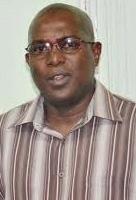
In the over-65s Barbadian Orson beat BVI’s Winston Findley 3-0.
In the Women’s over-35s, Guyana’s Kathy Ten Pow beat Vincentian Hazel-Anne Sandy 3-0.
In the 55-64 category, World Masters Semi-Finalist Mark Sealy beat Guyana Joe Mekdeci 3-0, Guyana’s Narendra Singh beat Bajan Sanjay Amin 3-0 and Brian Edwards beat Rob Edwards 3-0.
ra 3-0, Regan Pollard beat Jonathan Antczak 3-0, Nicolas Narine defeated Javid Rahaman 3-2 and Jason van Dijk beat Lee Fung-a-Fat 3-0 in the other 30-44 games played
The tournament was scheduled to conclude last night with the presentation Ceremony after Arjoon and Simpson battle for the BCQS Masters Squash tittle.
Brathwaite and Tagenarine
Chanderpaul adopted a painstaking approach to batting and enabled West Indies to make a stable start in the first Test against hosts Zimbabwe on Saturday, before adverse weather ended play early.
Windies captain
Brathwaite was not out on 55 and left-hander Chanderpaul, playing his third Test, was not out on the same score, and the Caribbean side were 112 without loss in their first innings with only 51 overs possible before rain stopped play about half-hour before the scheduled tea break on the first day.
The players never got a chance to return to the field with the weather wiping out the entire third and final ses-
sion of play. They were several occasions when the ground-staff
removed the covers and a resumption seemed imminent before umpires Langston
newcomer Jonathan Drakes, batting at three, led the way with 36, pacer Akeem Jordan, batting at eight, made 20, and Test batsman Shamar Brooks added 12.
The rest of the batting caved to disciplined, if not menacing bowling from the Harpy Eagles with pacer Ronsford Beaton ending with 2-11 from eight overs, and Test left-arm spinner Veerasammy Permaul taking 2-18 from eight overs.
The result meant that the Harpy Eagles start the tournament with a bag of 18 points, and the Pride limp away with only three.
Rusere and Paul Reiffel decided to abandon play about half-hour before the sched-
uled close.
Play will start on Sunday half-hour earlier than scheduled at 9:30 a.m. (3:30 East Caribbean Time) to make up for the time lost.

Brathwaite and Chanderpaul hardly placed a foot wrong in giving West Indies a firm foundation after the visitors decided to bat on the easy-paced Queen’s Sports Club pitch.

“I think the pitch looked good and I didn’t see much moisture in it,” Brathwaite said about the decision to bat. “I think it’s important for us to get a big first innings total, and that’s pretty much it. I think the pitch was playing good.
“With rain around, we have to see how the pitch plays, so starting over [on Sunday] will be crucial. [Saturday] is history. It is gone.
It’s important for me and Tage to go and start fresh [on Sunday] and continue to build the foundation for the team to get a big first innings total.”
Brathwaite said he enjoyed batting with the younger Chanderpaul and hailed the alliance they have formed so far at the top of the order over the three Tests.
“Tage is quite special,” he said. “I have played against him several times when he played for Guyana (Harpy Eagles) against Barbados (Pride).
“It’s great to see the fight that a young guy can come into the Test team and show – and even for me, he is an example for me to follow and I will just continue urging him, to be himself, and it’s truly an honour to bat with

UNDER the bright lights and soothing ambience at the 704 Sports Bar, the Rawle Toney 3x3 Basketball Classic was officially launched on Friday evening.

The tournament, which started in 2019, will host its third edition, this time in conjunction with the Guyana Basketball Federation (GBF).
Berbice and Guyana pacer Nial Smith took his third five-wicket haul in first-class cricket.
NORTH SOUND, Antigua, (CMC) – Two-time defending champions Barbados Pride were dealt a demoralising setback in the West Indies Championship on Saturday, when pacer Niall Smith produced a destructive spell to undermine their batting and bowled Guyana Harpy Eagles to a comprehensive 183-run win.

Smith grabbed 5-31 from 10 overs, and the Pride,
chasing 278 to win, were bowled out for a paltry 94 in their second innings shortly before tea on the final day of their first round match at the Vivian Richards Cricket Ground.
It was the third lowest total for Pride against the Harpy Eagles in the modern era of the Championship (1966 onwards) – but nowhere near their record lowest.
Only three Pride batsmen reached double figures –
In the second round, starting on Wednesday –Harpy Eagles face Windward Islands Volcanoes at the National Cricket Stadium in Grenada, and Pride meet Jamaica Scorpions at the Coolidge Cricket Ground in Antigua.
Earlier, Harpy Eagles added 35 to their overnight total before they declared their second innings inside the first hour on 126 for nine.
Permaul made 33, adding 22 to his overnight score, and Smith, not out on 12, provided a stable partner in TURN TO PAGE 37
Set for March 18 – 19 at the Burnham Basketball Court, the tournament will feature 16 teams, with participation from Trinidad and Tobago, St Lucia and Suriname.
“When I started this event in 2019, the goal was to produce a product that would attract teams from around the Caribbean,” Toney said.
Toney was at the time addressing an audience that included the media, sponsors and perspective sponsors.
The winner’s purse of $400,000 and runner-up’s prize of $200,000 was spon-
TURN TO PAGE 37